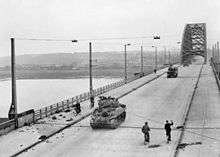Operation Market Garden
Operation Market Garden was a failed World War II military operation fought in the Netherlands from 17 to 25 September 1944. It was the brainchild of Field Marshal Sir Bernard Law Montgomery and strongly supported by Winston Churchill and Franklin Roosevelt. The airborne part of the operation was undertaken by the First Allied Airborne Army with the land operation by XXX Corps of the British Second Army.[14] The objective was to create a 64 mi (103 km) salient into German territory with a bridgehead over the River Rhine, creating an Allied invasion route into northern Germany.[3] This was to be achieved by seizing a series of nine bridges by Airborne forces with land forces swiftly following over the bridges. The operation succeeded in liberating the Dutch cities of Eindhoven and Nijmegen along with many towns, creating a 60 mi (97 km) salient into German-held territory limiting V-2 rocket launching sites. It failed, however, to secure a bridgehead over the Rhine, with the advance being halted at the river.
Market Garden consisted of two sub-operations:
- Market – an airborne assault to seize key bridges, and;
- Garden – a ground attack moving over the seized bridges creating the salient.
The attack was the largest airborne operation up to that point in World War II.[lower-alpha 5]
Supreme Commander General Eisenhower's strategic goal was to encircle the heart of German industry, the Ruhr Area, in a pincer movement. The northern end of the pincer would circumvent the northern end of the Siegfried Line, giving easier access into Germany across the north German plains enabling mobile warfare. The prime aim of Operation Market Garden was to establish the northern end of a pincer ready to project deeper into Germany. Allied forces would project north from Belgium, 60 miles (97 km) through the Netherlands, across the Rhine and consolidate north of Arnhem on the Dutch/German border, ready to close the pincer.[16]
The operation made massive use of airborne forces, whose tactical objectives were to secure the bridges and to allow a rapid advance by armored ground units to consolidate north of Arnhem. The operation required the seizure of the bridges by airborne troops across the Meuse River, two arms of the Rhine (the Waal River and the Lower Rhine), together with crossings over several smaller canals and tributaries. However, this large airborne force contrasted with the ground forces being light with only one corps moving north of Eindhoven, XXX Corps. XXX Corps took along 5,000 vehicles full of bridging equipment and 9,000 sappers.[14]
The Allies captured several bridges between Eindhoven and Nijmegen at the beginning of the operation. Lieutenant-General Brian Horrocks' XXX Corps ground force advance was delayed by the initial failure of the airborne units to secure bridges at Son en Breugel and Nijmegen. German forces demolished the bridge over the Wilhelmina Canal (nl:Wilhelminakanaal) at Son before it could be captured by the US 101st Airborne Division, although a Bailey bridge was then built over the canal by British sappers. This delayed XXX Corps' advance by 12 hours; however, they made up the time, reaching Nijmegen on schedule. The US 82nd Airborne Division's failure to capture the main highway bridge over the Waal River at Nijmegen before 20 September delayed the advance by 36 hours. XXX Corps had to seize the bridge themselves instead of speeding over a captured bridge onwards to Arnhem, where the British paratroopers were still holding the north end of the bridge.[17]
At the northern point of the airborne operation, the British 1st Airborne Division initially encountered strong resistance. The delays in capturing the bridge at Nijmegen and constructing a Bailey bridge at Son gave time for German forces (the 9th SS Panzer Division "Hohenstaufen" and 10th SS Panzer Division "Frundsberg", which were in the Arnhem area at the start of the jump) to organise their counterattack.[18] A small British force managed to capture the north end of the Arnhem road bridge, denying use of the intact bridge to German forces. After the ground forces failed to relieve the paratroopers on time, they were overrun on 21 September. At the same time that XXX Corps' tanks moved over the Nijmegen bridge, 36 hours late, after seizing it from the Germans, the British paratroopers at the Arnhem bridge were capitulating, unable to hold on any longer.[17] The remainder of the British 1st Airborne Division was trapped in a small pocket west of the Arnhem bridge, which was evacuated on 25 September after sustaining heavy casualties.
The Allies had failed to cross the Rhine. The river remained a barrier to their advance into Germany until offensives at Remagen, Oppenheim, Rees and Wesel in March 1945. The failure of Operation Market Garden to form a foothold over the Rhine ended Allied hopes of finishing the war by Christmas 1944.[19]
Background
After major defeats in Normandy in the summer of 1944, remnants of German forces withdrew across France and the Low Countries towards the German border by the end of August.[20] In the north, in the first week of September, the British 21st Army Group, under Field Marshal Bernard Montgomery, sent its British Second Army commanded by Lieutenant-General Sir Miles Dempsey advancing on a line running from Antwerp to the northern border of Belgium, while its First Canadian Army, under Lieutenant-General Harry Crerar, was pursuing its task of recapturing the ports of Dieppe, Le Havre, and Boulogne-sur-Mer.[21]
To the south, the U.S. 12th Army Group under Lt. General Omar Bradley was nearing the German border and had been ordered to line up within the Aachen gap with Lieutenant General Courtney Hodges' U.S. First Army, in support of Montgomery's advance on the Ruhr. Meanwhile, the group's U.S. Third Army, under Lieutenant General George S. Patton, moved eastward towards the Saarland.[22] At the same time, the U.S. 6th Army Group under Lt. General Jacob L. Devers was advancing towards Germany after their landings in southern France.[23]
Logistics problems
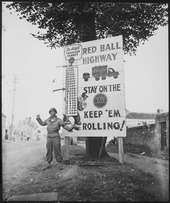
Before D-Day, to disrupt German logistics efforts, the Allies spent considerable effort in bombing the French rail network, although aware this would also affect their own operations in the event of a breakout. The plan of Overlord had foreseen this, and it called for the exploitation of the ports in Brittany to move the supply points forward as the armies moved.[24]
By August, supply sources for the armies were still limited to the original invasion beaches, the nearby deep water port of Cherbourg at the tip of the Cotentin peninsula, and some minor ports in Normandy.[25] Although over-the-beach supply operations outperformed expectations, September saw deteriorating weather and rising seas, and the end of their usefulness was clearly in sight.[26] Additional deepwater ports were therefore required; Cherbourg was useful, but it was far from the front. The Brittany ports, still occupied by stiff German resistance, were equally unsuitable as they were situated along the western coast of France and were overcome by the rapid Allied advance toward the east.[27]
On 4 September, Montgomery's troops captured the massive port of Antwerp virtually intact,[28] but the Scheldt Estuary leading to it was still under German control.[29] Some argued that the capture of Le Havre and Antwerp made the original plan of clearing French ports further south unnecessary.[30] Antwerp could have been opened sooner by the Canadian Army if Montgomery had given priority to clearing the approaches,[31] but Eisenhower and Montgomery persisted with the original plans to capture many of the French ports.[30]
The failure to open the harbours in Antwerp has been called "one of the greatest tactical mistakes of the war".[32] The "Great Mistake" also included not cutting off the German Fifteenth Army of 80,000 men who were trapped on the coast west of Antwerp, and who were evacuated north over the Scheldt Estuary and then east along the Beveland Peninsula. These forces unexpectedly joined the battles for the bridges in the Eindhoven and Nijmegen sectors.[33] Other important ports on the North Sea coast, such as Dunkirk, remained in German hands until May 1945.[34]
Major efforts to reopen the French railroad network were started, and by the end of August, 18,000 men, including 5,000 prisoners of war, were engaged in railway construction. After many delays, the first trainload of supplies reached the U.S. Third Army depot at Le Mans on 17 August. But these efforts were far too late to have any effect on the battles taking place after Operation Cobra and the following breakout into France. Instead, all supplies for the armies had to be carried forward by truck, and there were simply not enough trucks for this effort.[35] Advancing divisions of the U.S. 12th Army Group left all their heavy artillery and half their medium artillery west of the Seine, freeing their trucks to move supplies for other units.[36] The 21st Army Group stripped two of its divisions of their transport,[37] and four British truck companies were lent to the Americans.[38]
Organization of the Red Ball Express did much to lessen the impact of the transport shortage but this ad hoc operation could not solve the problem.[39] As the Allied pursuit across France and Belgium continued, distances increased beyond the range of a single truck, requiring fuel to be brought forward in those trucks to refuel the logistics further from the ports. Fuel consumption soared. Soon it took five gallons of fuel to deliver one gallon to the front. Fuel pipelines were constructed to shorten the supply lines, but were too time-consuming to build to be of much short-term use. By 28 August the Communications Zone could no longer guarantee fuel deliveries, and both the U.S. First and Third Armies reported less than a day's supply on hand.[40] Furthermore, the stripping of the armies of their own transport had the effect of seriously slowing their own maneuverability.
On 30 August, drastic steps were taken to suspend imports entirely; 21st Army Group would draw on its reserves in Normandy until the ports of Dieppe and Boulogne-sur-Mer could be opened.[41] The situation was exacerbated by the fact that 1,400 British three-ton trucks were found to be useless because of faulty metal alloy used for pistons in both their original and their replacement engines[42] – they could have moved 800 tons per day, enough for two divisions.[43] Offensive operations slowed to a standstill, allowing the German forces their first respite in weeks.
Strategy
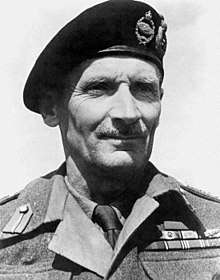
Following the Allied breakout from Normandy, and the closure of the Falaise Pocket, the Supreme Allied Commander of the Allied armies on the Western Front, General Dwight D. Eisenhower, favored pursuit of the seemingly shattered German armies northwards and eastwards across the Seine, and ultimately to the Rhine on a broad front. While agreeing that Montgomery's drive towards the Ruhr should have priority, he still thought it was important to "get Patton moving again". To that end, in the first week of September 1944, Eisenhower authorized the U.S. First Army to cross the Rhine near Cologne, Bonn, and Koblenz while the U.S. Third Army crossed near Mannheim, Mainz, and Karlsruhe. Eisenhower relied on speed, which in turn depended on logistics, which he conceded were "stretched to the limit".[44] This strategy was contested by his subordinates, particularly Montgomery, who argued that with the supply situation deteriorating, he would not be able to reach the Ruhr, but "a relocation of our present resources of every description would be adequate to get one thrust to Berlin".[45] Supreme Headquarters Allied Expeditionary Force (SHAEF) did provide Montgomery with additional resources, principally additional locomotives and rolling stock, and priority for air supply.[46]
Montgomery initially suggested Operation Comet, a limited airborne coup de main operation that was to be launched on 2 September 1944. Comet envisioned using the British 1st Airborne Division, along with the Polish 1st Independent Parachute Brigade, to secure several bridges over the Rhine River to aid the Allied advance into the North German Plain. The Divisional Headquarters for the British 1st Airborne Division, with the 1st Airlanding Brigade and the Polish 1st Independent Parachute Brigade were to land at Nijmegen, the British 1st Parachute Brigade was to land at Arnhem, and the British 4th Parachute Brigade was to land at Grave, Netherlands.[47] However several days of poor weather and Montgomery's concerns over increasing levels of German resistance caused him to postpone the operation and then cancel it on 10 September.[48]
Comet was replaced by a more ambitious plan to bypass the Siegfried Line by hooking around its northern end, allowing the Allies to cross the Rhine with large forces and trap the German Fifteenth Army by advancing from Arnhem to the shores of the IJsselmeer: Operation Market Garden. On 10 September Dempsey, the British Second Army commander, told Montgomery that he had doubts about this plan and that he instead favored an advance north-eastwards between the Reichswald forest and the Ruhr to Wesel. Montgomery replied that he had just received a signal from London that something needed to be done to neutralize the V-2 launch sites around The Hague (which were bombarding London) and that the plan must therefore proceed.[49]
Angered by Eisenhower's reluctance, Montgomery flew to Brussels that afternoon to meet him. Montgomery demanded that Eisenhower's Chief of Staff leave the meeting while insisting that his own should remain. He then tore a file of Eisenhower's messages to shreds in front of him, argued for a concentrated northern thrust, and demanding priority in supplies. So fierce and unrestrained was Montgomery's language that Eisenhower reached out, patted Montgomery's knee, and said, "Steady, Monty! You can't talk to me like that. I'm your boss."[50]
Eisenhower stated his belief that advance on a broad front would soon provoke German forces to collapse. He told Montgomery why a "single thrust" toward Berlin was not going to be accepted.
What you're proposing is this – if I give you all the supplies you want, you could go straight to Berlin – right straight (500 miles) to Berlin? Monty, you're nuts. You can't do it. What the hell[?] ... If you try a long column like that in a single thrust you'd have to throw off division after division to protect your flanks from attack.[50]
Nevertheless, Eisenhower consented to Operation Market Garden, giving it "limited priority" in terms of supplies – and only as part of an advance on a broad front.[51] Eisenhower promised that aircraft and trucks would deliver 1,000 tons of supplies per day.[52] In vain, Montgomery complained about this to the Vice-Chief of the Imperial General Staff (VCIGS) in London, Lieutenant-General Sir Archibald Nye.[53][lower-alpha 6]
For Market Garden, the U.S. 82nd and 101st Airborne Divisions would be maintained from British stocks for all common items such as food and fuel. Noncommon items like ammunition, ordnance, and signal and engineer stores were delivered by the Red Ball Express or by rail to No. 6 Army Roadhead at Grammont.[54] Three newly arrived U.S. infantry divisions (the 26th, 95th, and 104th) were stripped of their transportation, which was used to form provisional truck companies. These were assigned to the Red Ball Express, releasing eight companies to Red Lion, a special route to support Market-Garden. Red Lion convoys exceeded their target, delivering 650 tons per day instead of 500. Half of the tonnage hauled was supplies for the 82nd and 101st Airborne Divisions.[55]
Eisenhower's decision to launch Market Garden was influenced by his desire to keep the retreating Germans under pressure. However, he was also under pressure from the United States to use the First Allied Airborne Army as soon as possible.[56] After Normandy, the airborne forces (minus the British 6th Airborne Division, which remained in Normandy until early September) had been withdrawn to reform in England, re-forming into the First Allied Airborne Army of two British and three U.S. airborne divisions and the Polish 1st Independent Parachute Brigade.[57] In the following months, plans for eighteen airborne operations had been drafted but then cancelled at short notice, mostly when the rapidly moving Allied ground forces overran the intended drop zones.[48][lower-alpha 7]
Geography
Highway 69 (later nicknamed "Hell's Highway") leading through the planned route was two lanes wide, partly raised above a surrounding flat terrain of polder or floodplain. The ground on either side of the highway was in places too soft to support tactical vehicle movement and there were numerous dikes and drainage ditches. Dikes tended to be topped by trees or large bushes, and roads and paths were lined with trees. In early autumn this meant that observation would be seriously restricted.[59]
There were six major water obstacles between the XXX Corps' jumping-off point and the objective of the north bank of the Nederrijn: the Wilhelmina Canal at Son en Breugel 100 feet (30 m) wide; the Zuid-Willems Canal at Veghel 80 feet (20 m); the Maas River at Grave 800 feet (240 m); the Maas-Waal Canal 200 feet (60 m); the Waal River at Nijmegen 850 feet (260 m); and the Nederrijn at Arnhem 300 feet (90 m).[60] Plans were made to seize bridges across all these obstacles nearly simultaneously – any failure to do so could result in serious delay or even defeat. In case bridges were demolished by the Germans, XXX Corps had plans to rebuild them. To this end, a vast quantity of bridging material was collected, along with 2,300 vehicles to carry it and 9,000 engineers to assemble it.[60]
Although the area is generally flat and open with less than 30 feet (9 m) of variation in altitude, Lieutenant-General Brian Horrocks, commander of XXX Corps recalled that "The country was wooded and rather marshy which made any outflanking operation impossible."[61] There were two important hill areas, 300 feet (90 m) high, that represented some of the highest ground in the Netherlands; one north and west of Arnhem and one in the 82nd Airborne Division's zone, the Groesbeek ridge. Seizure and defence of this elevated terrain was considered to be vital to holding the highway bridges.[59]
Allied preparation
The plan of action consisted of two operations:
- Market: airborne forces of Lieutenant General Lewis H. Brereton's First Allied Airborne Army to seize bridges and other terrain, under tactical command of I Airborne Corps under Lieutenant-General Frederick Browning, and
- Garden: ground forces of the Second Army to move north spearheaded by XXX Corps under Lieutenant-General Brian Horrocks.[62]
Market
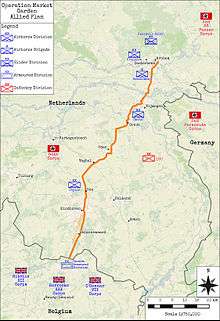
Market would employ four of the six divisions of the First Allied Airborne Army. The U.S. 101st Airborne Division, under Major General Maxwell D. Taylor, would drop in two locations just north of XXX Corps to take the bridges northwest of Eindhoven at Son and Veghel. The 82nd Airborne Division, under Brigadier General James M. Gavin, would drop northeast of them to take the bridges at Grave and Nijmegen and the British 1st Airborne Division, under Major-General Roy Urquhart, with the Polish 1st Independent Parachute Brigade, under Brigadier General Stanisław Sosabowski, attached would drop at the extreme north end of the route, capturing the road bridge at Arnhem and the rail bridge at Oosterbeek. The 52nd (Lowland) Infantry Division would be flown to the captured Deelen Airfield on D+5.[63]
The First Allied Airborne Army had been created on 16 August as the result of British requests for a coordinated headquarters for airborne operations, a concept approved by General Eisenhower on 20 June. The British had strongly hinted that a British officer – Browning in particular – be appointed its commander. Browning for his part decided to bring his entire staff with him on the operation to establish his field HQ using the much-needed 32 Horsa gliders for administrative personnel, and six Waco CG-4A gliders for U.S. Signals’ personnel. Since the bulk of both troops and aircraft were American, Brereton, a U.S. Army Air Forces officer, was named by Eisenhower on 16 July and appointed by SHAEF on 2 August. Brereton had no experience in airborne operations but had extensive command experience at the air force level in several theaters, most recently as commander of Ninth Air Force, which gave him a working knowledge of the operations of IX Troop Carrier Command.[64]
Market would be the largest airborne operation in history, delivering over 34,600 men of the 101st, 82nd and 1st Airborne Divisions and the Polish Brigade. 14,589 troops were landed by glider and 20,011 by parachute. Gliders also brought in 1,736 vehicles and 263 artillery pieces. 3,342 tons of ammunition and other supplies were brought by glider and parachute drop.[65]
To deliver its 36 battalions of airborne infantry and their support troops to the continent, the First Allied Airborne Army had under its operational control the 14 groups of IX Troop Carrier Command,[66][lower-alpha 8] and after 11 September the 16 squadrons of 38 Group (an organization of converted bombers providing support to resistance groups) and a transport formation, 46 Group.[67]
The combined force had 1,438 C-47/Dakota transports (1,274 USAAF and 164 RAF) and 321 converted RAF bombers. The Allied glider force had been rebuilt after Normandy until by 16 September it numbered 2,160 CG-4A Waco gliders, 916 Airspeed Horsas (812 RAF and 104 U.S. Army) and 64 General Aircraft Hamilcars. The U.S. had only 2,060 glider pilots available, so that none of its gliders would have a co-pilot but would instead carry an extra passenger.[68]
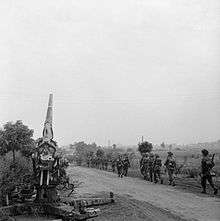
Because the C-47s served as paratrooper transports and glider tugs and because IX Troop Carrier Command would provide all the transports for both British parachute brigades, this massive force could deliver only 60 percent of the ground forces in one lift. This limit was the reason for the decision to split the troop-lift schedule into successive days. Ninety percent of the USAAF transports on the first day would drop parachute troops, with the same proportion towing gliders on the second day (the RAF transports were almost entirely used for glider operations).[lower-alpha 9] Brereton rejected having two airlifts on the first day, although this had been accomplished during Operation Dragoon, albeit with slightly more daylight (45 minutes) and against negligible opposition.[70]
17 September was on a dark moon and in the days following it the new moon set before dark. Allied airborne doctrine prohibited big operations in the absence of all light, so the operation would have to be carried out in daylight. The risk of Luftwaffe interception was judged small, given the crushing air superiority of Allied fighters but there were concerns about the increasing number of flak units in the Netherlands, especially around Arnhem. Brereton's experience with tactical air operations judged that flak suppression would be sufficient to permit the troop carriers to operate without prohibitive loss. The invasion of Southern France had demonstrated that large scale daylight airborne operations were feasible.[71] Daylight operations, in contrast to those in Sicily and Normandy, would have much greater navigational accuracy and time-compression of succeeding waves of aircraft, tripling the number of troops that could be delivered per hour. The time required to assemble airborne units on the drop zone after landing would be reduced by two-thirds.[72]
IX Troop Carrier Command's transport aircraft had to tow gliders and drop paratroopers, duties that could not be performed simultaneously. Although every division commander requested two drops on the first day, Brereton's staff scheduled only one lift based on the need to prepare for the first drop by bombarding German flak positions for half a day and a weather forecast on the afternoon of 16 September (which soon proved erroneous) that the area would have clear conditions for four days, so allowing drops during them.[73]
After one week preparations were declared complete. The planning and training for the airborne drops at Sicily and Normandy had taken months. One United States Air Force historian noted that 'Market' was the only large airborne operation of World War II in which the USAAF "had no training program, no rehearsals, almost no exercises, and a...low level of tactical training."[74]
Gen. Gavin, commanding the U.S. 82nd Airborne Division, was skeptical of the plan. In his diary he wrote, "It looks very rough. If I get through this one I will be very lucky." He was also highly critical of Browning, writing that he "...unquestionably lacks the standing, influence and judgment that comes from a proper troop experience... his staff was superficial... Why the British units fumble along... becomes more and more apparent. Their tops lack the know-how, never do they get down into the dirt and learn the hard way."[75]
Garden
Garden consisted primarily of XXX Corps and was initially spearheaded by the Guards Armoured Division, with the 43rd Wessex and 50th Northumbrian Infantry Divisions in reserve. They were expected to arrive at the south end of the 101st Airborne Division's area on the first day, the 82nd's by the second day and the 1st's by the fourth day at the latest. The airborne divisions would then join XXX Corps in the breakout from the Arnhem bridgehead.[63]
Four days was a long time for an airborne force to fight unsupported. Even so, before Operation Market Garden started it seemed to the Allied high command that the German resistance had broken. Most of the German Fifteenth Army in the area appeared to be fleeing from the Canadians and they were known to have no Panzergruppen. It was thought that XXX Corps would face limited resistance on their route up Highway 69 and little armour. Meanwhile, the German defenders would be spread out over 100 kilometres (62 mi) trying to contain the pockets of airborne forces, from the Second Army in the south to Arnhem in the north.[76]
German preparation
The rout of the Wehrmacht during July and August led the Allies to believe that the German army was a spent force unable to reconstitute its shattered units. During those two months the Wehrmacht had suffered a string of defeats with heavy losses. Between 6 June and 14 August it had suffered 23,019 killed in action, 198,616 missing or taken prisoner and 67,240 wounded.[77] Many of the formations the Wehrmacht had at the beginning of the Normandy campaign been annihilated or reduced to skeleton formations by the end of August.[77] As the German armies retreated towards the German frontier, they were often harried by air attacks and bombing raids by aircraft of the Allied air forces, inflicting casualties and destroying vehicles.[78] Attempts to halt the Allied advance often seemed fruitless as hurried counter-attacks and blocking positions were brushed aside and at times there seemed to be too few German units to hold anywhere.[79] By early September the situation was beginning to change. 65,000 troops of the German Fifteenth Army were extricated from the area with 225 guns and 750 trucks by a flotilla of commandeered freighters, barges and small boats. From there they moved to the Netherlands.[80]
Adolf Hitler began to take a personal interest in the apparent disintegration of Army Group B, which comprised the German armies in northern France, Belgium, and the Netherlands. On 4 September he recalled Generalfeldmarschall Gerd von Rundstedt, who had been in retirement since Hitler had dismissed him as Wehrmacht Commander-in-Chief West on 2 July, and reinstated him in his former command,[81] replacing Generalfeldmarschall Walter Model, who had taken command just 18 days previously and would henceforth command only Army Group B.[82] Rundstedt immediately began to plan a defence against what Wehrmacht intelligence judged to be 60 Allied divisions at full strength, although Eisenhower in fact possessed only 49 divisions.[83]
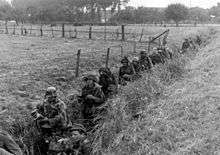
Model set out to stop the Allied advance. The German 719th Infantry Division, part of LXXXVIII Corps, was dispatched south to the Albert Canal and Model requested reinforcements from Germany, stating that he would require 25 infantry divisions and six armoured divisions to hold; he envisioned a line stretching from Antwerp via Maastricht to Metz and from there to follow the line of the Albert Canal to the Meuse and the Siegfried Line.[84] Meanwhile, Colonel General Kurt Student, commander of the Fallschirmjaeger, the German airborne forces, received orders from Alfred Jodl, Chief of the Operations Staff of the Oberkommando der Wehrmacht, to immediately move from Berlin and proceed to the Netherlands, where he would collect all available units and build a front near the Albert Canal, which was to be held at all costs.[85] This front was to be held by the new First Parachute Army, a euphemistic name for a paper formation. Its units were scattered throughout Germany and the Netherlands and consisted either of units in the process of being formed or remnants cadred by survivors of previous units.[85][86]
Though the situation seemed dire, the German front was beginning to form into what Robert Kershaw terms "a crust". Leadership, initiative, and a good staff system were beginning to create a defense out of chaos.[87] On 4 September, the 719th infantry division began to dig in along the Albert Canal and was soon joined by forces under the command of Lieutenant General Kurt Chill.[88] Although Chill only officially commanded the 85th Infantry Division, which had suffered heavy casualties during the retreat from Normandy, he had assumed command of the remnants of the 84th and 89th Infantry Divisions en route. Initially ordered to take his command to the Rhineland for rest and reinforcements, Chill disregarded the order and moved his forces to the Albert Canal, linking up with the 719th; he also had "reception centers" set up at the bridges crossing the Albert Canal, where small groups of retreating troops were picked up and turned into ad hoc units.[87][88] By 7 September the 176th Infantry Division, a Kranken division composed of elderly men and men with various medical complaints, had arrived from the Siegfried Line and elements of the First Parachute Army began to appear. At this stage the Army consisted of approximately seven Fallschirmjaeger regiments composed of some 20,000 airborne troops along with a collection of anti-aircraft batteries and a mix of 25 self-propelled guns and tank destroyers.[89] Kriegsmarine and SS units were also allocated to Student's command, and Hitler had promised Model that 200 Panther tanks would be sent straight from the production lines; he also ordered all Tiger tanks, Jagdpanther self-propelled guns, and 88 mm guns that were available in Germany to be transferred to the West.[90]
On 5 September, Model's forces were bolstered by the arrival of the II SS Panzer Corps, which consisted of the 9th SS and 10th SS Panzer Divisions under the command of Lieutenant General Wilhelm Bittrich. The Corps had been reduced to approximately 6,000–7,000 men, 20–30% of its original strength in the course of continuous action since late June including in the Falaise pocket; losses in officers and NCOs had been especially high.[91] Model ordered the two divisions to rest and refit in "safe" areas behind the new German line; these areas coincidentally were to be Eindhoven and Arnhem.[92] The 10th SS Panzer Division was to be restored to full strength in order to provide an armored reserve and thus the 9th SS Panzer Division was ordered to transfer all of its heavy equipment to its sister division; it was intended that the 9th would then be transported to Germany for replenishment.[91] At the time of Operation Market-Garden, the 10th SS Panzer Division had an approximate strength of 3,000 men; an armored infantry regiment, divisional reconnaissance battalion, two artillery battalions, and an engineer battalion, all partially motorized.[lower-alpha 10] Other formations were appearing to strengthen the German defenses. Between 16 and 17 September, two infantry divisions from Fifteenth Army assembled in Brabant, under strength but well-equipped and able to act as a reserve.[94] Near Eindhoven and Arnhem a number of scratch formations were being assembled. Several SS units, including an NCO training battalion and a panzergrenadier reserve battalion, were being prepared to enter combat and Luftwaffe and Kriegsmarine personnel were being grouped into Fliegerhorst and Schiffstammabteilung formations. There were also a number of training battalions that were being equipped, several depot battalions from the Panzer Division Hermann Göring and various artillery, anti-aircraft, and field police units scattered throughout the north of the Netherlands.[95]
Intelligence
German
Rundstedt and Model suspected that a large Allied offensive was imminent, having received many intelligence reports that described a 'constant stream' of reinforcements to the right wing of the British Second Army.[96] The senior intelligence officer of Army Group B believed the Second Army would launch an offensive in the direction of Nijmegen, Arnhem and Wesel with a primary objective of reaching the industrial area along the Ruhr river. He was convinced that airborne troops would be used in this offensive but was unsure where they would be deployed, suspecting areas along the Siegfried Line north of Aachen or possibly even near the Saar.[97] Second Army would assemble its units at the Maas-Scheldt and Albert Canals. The right wing of the Army would be the assault force, composed primarily of armoured units, which would force a crossing of the Maas and attempt to break through to the Ruhr industrial area near Roermond. The left wing would cover the Army's northern flank by moving up to the Waal near Nijmegen and isolating the German 15th Army situated on the Dutch coast.[97][98]
Allied
A number of reports about German troop movements reached Allied high command, including details of the identity and location of German armored formations. The UK Government Code and Cypher School at Bletchley Park which monitored and decrypted German radio traffic produced intelligence reports codenamed Ultra. These were sent to senior Allied commanders, but they only reached army headquarters level and were not passed down any lower.[93] On 16 September Ultra reports revealed the movement of the 9th SS and 10th SS Panzer Divisions to Nijmegen and Arnhem, creating enough concern for Eisenhower to send his Chief of Staff, Lieutenant General Walter Bedell Smith, to raise the issue with Montgomery on 10 September. However, Montgomery dismissed Smith's concerns and refused to alter the plans for the landing of 1st Airborne Division at Arnhem.[99] Further information about the location of the German Panzer Divisions at Arnhem was revealed by aerial photographs of Arnhem taken by a photo-reconnaissance Spitfire XI from RAF's No. 16 Squadron,[100] as well as information from members of the Dutch resistance.[101] Fearing that 1st Airborne Division might be in grave danger if it landed at Arnhem the chief intelligence officer of the division, Major Brian Urquhart, arranged a meeting with Browning and informed him of the armour present at Arnhem. Browning dismissed his claims and ordered the division's senior medical officer to send Urquhart on sick leave on account of "nervous strain and exhaustion".[102]
Battle
Day 1: Sunday, 17 September 1944
Early successes
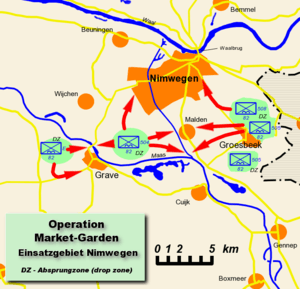
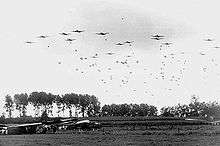
Operation Market Garden opened with Allied success all round. In the first landing, almost all troops arrived on top of their drop zones without incident. In the 82nd Airborne Division, 89% of troops landed on or within 1,000 metres (3,300 ft) of their drop zones and 84% of gliders landed on or within 1,000 metres (3,300 ft) of their landing zones. This contrasted with previous operations where night drops had resulted in units being scattered by up to 19 kilometres (12 mi). Losses to enemy aircraft and flak were light; German flak was described in reports as "heavy but inaccurate". However, all water crossings were 100% in allied hands, or German troops prevented from using the crossing, at the end of the first day, except the large Nijmegen bridge.
In the south, the 101st met little resistance and captured four of five bridges assigned to them. After a brief delay caused by four 88 mm guns and a machine gun post, the bridge at Son was blown up by the Germans on approach. Later that day several small attacks by the German 59th Infantry Division were beaten off. Small units of the 101st moved south of Son, towards Eindhoven. Later that day they made contact with German forces. Elements of the 44th Royal Tank Regiment who were advancing in the VIII Corps sector assisted the 101st.[103]

To their north, the 82nd arrived with a small group dropped near Grave securing the bridge. They also succeeded in capturing one of the vitally important bridges over the Maas-Waal canal, the lock-bridge at Heumen. The 82nd concentrated their efforts to seize the Groesbeek Heights instead of capturing their prime objective, the Nijmegen bridge. The capture of the Groesbeek Heights was to set up a blocking position on the high ground to prevent a German attack out of the nearby Reichswald and to deny the heights to German artillery observers. Browning, the commander of the 1st Airborne Army agreed with the assertions of Gavin, the commander of the 82nd, that Groesbeek Heights are the priority. Gavin wanted to occupy the Grave and the Maas (Meuse)-Waal canal bridges before Nijmegen bridge. He would attempt to seize the Nijmegen bridge only when these were secure, thus releasing troops for Nijmegen. Before the operation on 15 September Gavin verbally ordered Lt-Col Linquist of the 508th Parachute Infantry Regiment to send a battalion to the Nijmegen bridge after landing. He had decided that there were enough troops for the other objectives. Linquist later said he understood he should send a battalion after his regiment had completed their earlier assigned targets. Linquist's battalion approached the bridge that evening delaying the seizure of the bridge. The battalion was stopped by a SS unit that had driven south from Arnhem. A part of the SS unit returned to Arnhem but found the northern end of the Arnhem bridge occupied by the British 1st Airborne. In an attempt to cross the bridge most of the SS unit was killed including the commander.[104]
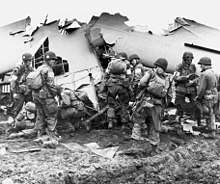
The 508th was tasked with taking the 600-metre (2,000 ft) long Nijmegen highway bridge if possible but because of miscommunication they did not start until late in the day. General Gavin's orders to Colonel Lindquist of the 508th were to "move without delay" onto the Nijmegen road bridge. Lindquist's 508th started jumping at 13:28 with 1,922 men. The jump was perfect with the regiment 90% assembled by 15:00. The commander of 3rd Battalion wrote later that..."we could not have landed better under any circumstances". The 508th was still sitting around when Gavin asked them at 18:00 if they had got to the bridge yet.[105]
They faced the same disadvantage as the British at Arnhem in dropping many miles from their objective. If they had attacked earlier they would have faced only a dozen German bridge guards. By the time the 508th attacked, troops of the 10th SS Reconnaissance Battalion were arriving. The attack failed, leaving the Nijmegen bridge in German hands.
Capturing this bridge was vital. Unlike some of the bridges to the south which were over smaller rivers and canals that could be bridged by engineering units, the Nijmegen and Arnhem bridges crossed two arms of the Rhine that could not be bridged easily. If either of the Nijmegen or Arnhem bridges were not captured and held, the advance of XXX Corps would be blocked and Operation Market Garden would fail.
British landings
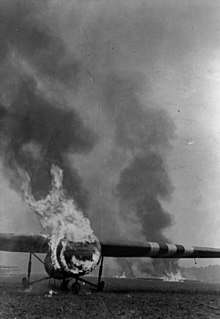
The 1st Airborne Division landed at 13:30 without serious incident but problems associated with the poor plan began soon after. Only half of the Division arrived with the first lift and only half of these (1st Parachute Brigade) could advance on the bridge. The remaining troops had to defend the drop zones overnight for the arrival of the second lift on the following day. Thus the Division's primary objective had to be tackled by less than half a brigade. While the paratroopers marched eastwards to Arnhem, the Reconnaissance Squadron was to race to the bridge in their jeeps and hold it until the rest of the Brigade arrived. The unit set off to the bridge late and having traveled only a short distance the vanguard was halted by a strong German defensive position; the squadron could make no further progress.
This had grave consequences. Five hours after the initial landing, feeling that the British were tied down in Arnhem, the Reconnaissance Battalion of the 9th SS Panzer Division was able to cross the Arnhem bridge and drive to Nijmegen and the bridge over the Waal branch of the Rhine. No British airborne unit was at the bridge.
Arnhem veteran Tom Hicks of 1st Parachute Squadron of the Royal Engineers described the problems the paratroops faced: "They (the Germans) had guns that out-ranged ours. We had no artillery with us so they could just lay off and pick you off kind of thing. If we wanted to get a gun out of action we had to send a patrol out, do it man to man kind of thing."[106]
Two of the three battalions of the 1st Parachute Brigade were slowed down by small German units of a training battalion which had quickly established a thin blocking line covering the obvious routes into Arnhem. Lieutenant-Colonel John Frost's 2nd Parachute Battalion, advancing eastwards along the southernmost road into Arnhem near the Rhine, found its route largely undefended. They arrived at the bridge in the evening and set up defensive positions at the north end. They were joined by Brigade HQ, led by Major Tony Hibbert, which was the brigade's only other unit to reach the bridge.[107][108][109]
Two attempts to capture the arched steel bridge and its southern approach failed. Of the other battalions, the 3rd Parachute Battalion had covered only half the distance to the bridge when they halted for the night, the rear of their column being under attack and needing time to catch up. The 1st Parachute Battalion was similarly fragmented, yet pushed on around the flank of the German line throughout the night. Frequent skirmishes resulted in their making little more progress. The 3rd Battalion under Captain James Cleminson, KBE, MC, ambushed a German staff car and killed the commander of Arnhem's garrison, Major-General Friedrich Kussin, as well as his aide and his driver.
Communication breakdown
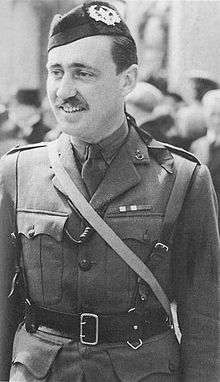
Some loss of communication between the bridge and divisional headquarters in one of the drop zones was expected, because 13 km (8.1 mi) separated them and the main radio was the Type 22 set, with an effective range of 5 km (3.1 mi).[110] The British radios did not function at any range; some had difficulty receiving signals from just a few hundred metres and others received nothing at all. It was found after landing that the radios had been set to different frequencies, two of which coincided with German and British public broadcasting stations.[110] Other theories have been advanced to explain the greatly reduced range of the 1st Airborne Division radio sets. Thus communication between 1st Airborne units was poor while German defence were being coordinated and reinforced. John Greenacre's study points out that radio communications failures were experienced by the division before, were warned about prior to the operation and provided for by bringing extra field telephone wire. The more powerful WS19HP set was used by the 1st Brigade on D+1.[111]
The only means of calling for air support was through two special American units dropped with the 1st Airborne Division. These units were equipped with "Veeps": jeeps having Very High Frequency SCR-193 crystal sets. It was found impossible to communicate with aircraft on the higher of two frequencies for this and the sets could not be tuned to the lower frequency.[112] Despite efforts to re-tune them, one set was soon destroyed by mortar fire and the other abandoned the next day, cutting the only possible link with RAF fighter-bombers. The pilots were under orders not to attack on their own initiative, since from the air there was no easy way to distinguish friend from foe; together with poor weather, this led to a lack of air support. After the war it was found that the Royal Corps of Signals was either unaware or failed to tell divisional signals of the communication problems identified in November 1943 due to sun spots by the Scientific Advisor's Office to the 21st Army Group. Urquhart ordered the 4-metre (13 ft) aerials to be used, which were useless due to the physics of radio propagation. The wrong frequencies were part of the same problem due to signals personnel not knowing the science of radio communications.[113]
XXX Corps advance
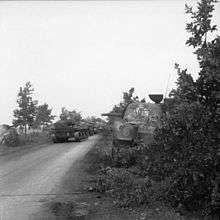
On the morning of 17 September Lieutenant-General Brian Horrocks was given confirmation that the operation was to take place that day.[114] At 12:30 hours Horrocks received a signal that the first wave of the airborne forces had left their bases within the United Kingdom and set the time for the ground attack to start at 14:35 hours.[114] At 14:15 hours[115] 300 guns of the Corps artillery opened fire, firing a rolling barrage in front of XXX Corps start line[114][116] that was 1 mile (1.6 km) wide and 5 miles (8.0 km) in depth.[117] The barrage was supported by seven squadrons of RAF Hawker Typhoons firing rockets at all known German positions along the road to Valkenswaard.[114][116] The advance was led by tanks and infantry of the Irish Guards[114] and started on time when Lieutenant Keith Heathcote, commanding the lead tank, ordered his driver to advance.[117] The lead units of the Irish Guards Group had broken out of XXX Corps bridgehead on the Maas-Schelde canal and crossed into the Netherlands by 15:00 hours.[114][117] After crossing the border the Irish Guards were ambushed by infantry and anti-tank guns dug in on both sides of the main road.[114][117] Portions of the artillery barrage were refined and fresh waves of Hawker Typhoons were called in.[114] The Guardsmen moved forward to clear the German positions, manned by elements from two German parachute battalions and two battalions of the 9th SS Panzer Division,[114] and soon routed the German forces flanking the road.[118] Interrogation of captured German soldiers led to some of them willingly,[116] others after being threatened, pointing out the remaining German positions.[116][118][119] The fighting soon died down and the advance resumed. By last light the town of Valkenswaard had been reached and occupied by the Irish Guards Group.[114][120][121]
Horrocks had expected that the Irish Guards would have been able to advance the 13 miles (21 km) to Eindhoven within two-three hours; however, they had only covered 7 miles (11 km). The operation was already starting to fall behind schedule.[121] In Valkenswaard engineers were moved up to construct a 190 foot (58 m) Class 40 Bailey bridge over a stream, which was completed within 12 hours.[120]
German reactions
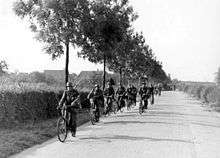
On the German side, it was soon clear what was happening. Model was staying at the Tafelberg Hotel in Oosterbeek, a village to the west of Arnhem, when the British began to land in the countryside to the west of Oosterbeek. He rapidly deduced the likely focus of the attack and after evacuating his headquarters, organized a defense. Bittrich sent a reconnaissance company of the 9th SS Panzer Division to Nijmegen to reinforce the bridge defenses. By midnight, Model had gained a clear picture of the situation and had organized the defense of Arnhem. The confusion usually caused by airborne operations was absent at Arnhem and the advantage of surprise was lost. During the operation, the Germans (allegedly) recovered a copy of the Market-Garden plan from the body of a British officer, who should not have carried it into combat.[122]
Day 2: Monday, 18 September
Allied weather forecasters correctly predicted that England would be covered in fog on the morning of 18 September. The Second Lift was postponed for three hours and thick low clouds began to develop over the southern part of the battle zone, spreading during the day over the area, hampering supply and air support (Seven of the next eight days had poor weather and all air operations were cancelled on 22 and 24 September).
1st Airborne zone
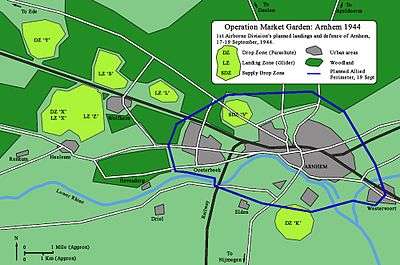
The 1st and 3rd Parachute Battalions pushed towards the Arnhem bridge during the early hours and had made good progress but they were frequently halted in skirmishes as soon as it became light. With their long and unwieldy columns having to halt to beat off attacks whilst the troops in front carried on unaware, the Germans delayed segments of the two battalions, fragmented them and mopped up the remnants.

Early in the day the 9th SS Reconnaissance Battalion (sent south the day before) concluded it was not needed in Nijmegen and returned to Arnhem. Though aware of the British troops at the bridge, it attempted to cross by force and was beaten back with heavy losses, including its commanding officer, SS-Hauptsturmführer Viktor Gräbner.
By the end of the day the 1st and 3rd Parachute Battalions had entered Arnhem and were within 2 km (1.2 mi) of the bridge with approximately 200 men, one-sixth their original strength. Most of the officers and non-commissioned officers had been killed, wounded or captured. The Second Lift was delayed by fog and jumped onto a landing zone under heavy attack but landed at full strength (the 4th Parachute Brigade consisting of the 10th, 11th and 156th Battalions of the Parachute Regiment, commanded by Brigadier-General John Winthrop Hackett) and C and D Companies of the 2nd South Staffordshire Regiment.
82nd Airborne zone
Grave proved to be well defended and German forces continued to press on the 82nd deployed on the Groesbeek heights to the east of Nijmegen. The 505th Parachute Infantry Regiment defended against German attacks in Horst, Grafwegen and Riethorst. Early in the day, German counterattacks seized one of the Allied landing zones where the Second Lift was scheduled to arrive at 13:00. The 508th Parachute Infantry Regiment attacked at 13:10 and cleared the landing zone by 14:00, capturing 16 German Flak pieces and 149 prisoners.[123] Delayed by weather in Britain, the Second Lift did not arrive until 15:30. This lift brought in elements of the 319th and 320th Glider Field Artillery battalions, the 456th Parachute Field Artillery battalion and medical support elements. Twenty minutes later, 135 B-24 bombers dropped supplies from low level.
101st Airborne zone

Faced with the loss of the bridge at Son, the 101st unsuccessfully attempted to capture a similar bridge a few kilometres away at Best but found the approach blocked. Other units continued moving to the south and eventually reached the northern end of Eindhoven. At 06:00 hours the Irish Guards Group resumed the advance while facing determined resistance from German infantry and tanks.[120] Around noon the 101st Airborne were met by the lead reconnaissance units from XXX Corps. At 16:00 radio contact alerted the main force that the Son bridge had been destroyed and requested that a Bailey bridge be brought forward. By nightfall, the Guards Armored Division had established itself in the Eindhoven area. However, transport columns were jammed in the packed streets of the town, and they were subjected to German aerial bombardment during the night. XXX Corps engineers, supported by German prisoners of war, constructed a class 40 Bailey bridge within 10 hours across the Wilhelmina Canal.[124] During the day the British VIII and XII Corps, supporting the main attack, had forged bridgeheads across Meuse-Escaut Canal while facing stiff German resistance; the 50th (Northumbrian) Infantry Division was transferred from XXX Corps to VIII Corps so to relieve XXX Corps from having to secure the ground gained thus far. Throughout the day German attacks were launched against XXX Corps and against the newly gained bridgeheads over the Meuse–Escaut Canal, all without success.[125]
Day 3: Tuesday, 19 September
Arnhem
At 3:00 a.m., the commanders of the 2nd battalion and the 1st and 11th parachute battalions met to plan their attack. At 4:30 a.m., before dawn,[126] the 1st Parachute Brigade began its attack towards Arnhem Bridge, with the 1st Battalion leading supported by remnants of the 3rd Battalion, with the 2nd South Staffordshires on the 1st Battalion's left flank and the 11th Battalion following. As soon as it became light the 1st Battalion was spotted and halted by fire from the main German defensive line. Trapped in open ground and under heavy fire from three sides, the 1st Battalion disintegrated and what remained of the 3rd Battalion fell back. The 2nd South Staffordshires were similarly cut off and, save for about 150 men, overcome by midday.[127] The 11th Battalion, (which had stayed out of much of the fighting) was then overwhelmed in exposed positions while attempting to capture high ground to the north. With no hope of breaking through, the 500 remaining men of these four battalions withdrew westwards in the direction of the main force, 5 km (3.1 mi) away in Oosterbeek.[128]
The 2nd Battalion and attached units (approximately 600 men) were still in control of the northern approach ramp to the Arnhem bridge. They had been ceaselessly bombarded by enemy tanks and artillery from two battle groups led by SS-Sturmbannführer Brinkmann and one commanded by Major Hans-Peter Knaust. The Germans recognized that they would not be moved by infantry attacks such as those that had been bloodily repulsed on the previous day so instead they heavily shelled the short British perimeter with mortars, artillery and tanks; systematically demolishing each house to enable their infantry to exploit gaps and dislodge the defenders. Although in battle against enormous odds, the British clung to their positions and much of the perimeter was held.[129]
Oosterbeek

To the north of Oosterbeek, the 4th Parachute Brigade led an attempt by the 1st Airborne Division to break through the German lines, but communication difficulties between British paratroopers and General Frederick Browning and the Americans, and enemy resistance, caused the attack to fail with heavy losses. The 1st Airborne Division, scattered far and wide and hard pressed by the enemy on all sides, had lost its offensive capability.[130] Unable to help Lt.-Col. Frost, who commanded the only battalion that had made it to the Arnhem bridge, the remaining soldiers attempted to withdraw into a defensive pocket at Oosterbeek and hold a bridgehead on the north bank of the Rhine after overwhelming German resistance.[131]
At 16:00 hours the British 4th Parachute Brigade's withdrawal was supported by the arrival of 35 gliders containing a portion of the 1st Polish Independent Parachute Brigade and its anti-tank battery, who were deployed in a Landing Zone still controlled by the enemy, which killed all but a small contingent of the reinforcements. While the drop of the remainder of the Polish paratroopers was postponed due to dense fog, its commander General Sosabowski was parachuted in to Driel.[132][133][134]
Nijmegen
At 08:20, the 504th Parachute Infantry Regiment made contact with the Grenadier Guards of the XXX Corps advancing north at Grave. This enabled the regiment to move on to other missions and place the 3rd Battalion in division reserve. XXX Corps were eight miles (13 km) from Arnhem with six hours in hand, "The earlier delays had been made up"[135] Control of all troops now fell to XXX Corps whose prime objective was to seize the Nijmegen bridge having two companies from the Guards Armoured Division assisted by the US 2nd Battalion, 505th Parachute Infantry Regiment. The attack got within 400 metres (440 yards) of the bridge before being halted; skirmishing continued throughout the night. A plan was made to attack the south end of the bridge again with support from the 3rd Battalion, 504th Parachute Infantry Regiment, who would cross the River Waal in boats 2 km (1.2 mi) downstream of the bridge and then attack the north end. The boats were requested for late afternoon, however they did not arrive as requested.
The 1st and 5th Battalions, Coldstream Guards, were attached to the division. A supply attempt by 35 C-47s (out of 60 sent) was unsuccessful; the supplies were dropped from a high altitude and could not be recovered. Bad weather over English bases prevented the scheduled big glider mission carrying the 325th Glider Infantry Regiment from taking off, ending any hope for the scheduled reinforcements for the 82nd Airborne.
Wijchen
At 09:50 the 504th Parachute Infantry Regiment was going forward to Wijchen, to attack the Edithbridge from its south end. The bridge was secured. After this fierce engagement they pushed on to the traffic bridge south of Wijchen. Another fierce engagement followed and this bridge was secured.
Eindhoven–Veghel
To their south, units of the 101st sent to take Best the day before, were forced to yield to German counter-attacks during the morning. British tanks arriving during the day helped push back the Germans by late afternoon. Later a small force of Panther tanks arrived at Son and started firing on the Bailey bridge. These too were beaten back by anti-tank guns that had recently landed and the bridge was secured. On the night of 19/20 September, 78 German bombers took off to attack Eindhoven. The Allies had no anti-aircraft guns in the city, allowing the Germans to drop "a clear golden cluster of parachute flares" and bomb Eindhoven without loss.[136] The city centre was shattered and the water pressure failed; over 200 houses were "gutted" and 9,000 buildings were damaged, with over 1,000 civilian casualties, including 227 dead.[137][138] An ammunition convoy and trucks carrying gasoline were also hit.[139] General Matthew Ridgway, in Eindhoven during the attack, wrote: "Great fires were burning everywhere, ammo trucks were exploding, gasoline trucks were on fire, and debris from wrecked houses clogged the streets."[137] Elements of the 101st, based in and around the city, witnessed the attack and escaped loss.[138] The 506th Parachute Infantry Regiment rushed into the burning city and rescued civilians during the night. According to Rick Atkinson, this was "the only large, long-range air strike by German bombers during the fall of 1944".[140]
Day 4: Wednesday, 20 September
Arnhem bridge
Lt. Colonel John Frost's force at the bridge continued to hold and established communication via the public telephone system with 1st Division around noon learning that the division had no hope of relieving them and that XXX Corps was stopped to the south in front of Nijmegen bridge. By the afternoon the British positions around the north end of Arnhem bridge had weakened considerably. Casualties, mostly wounded, were high from constant shelling. An acute lack of ammunition, especially anti-tank munitions, enabled enemy armor to demolish British positions from point-blank range. Food, water and medical supplies were scarce, and so many buildings were on fire and in such serious danger of collapse that a two-hour truce was arranged to evacuate the wounded (including Lieutenant-Colonel Frost) into German captivity. Frederick Gough took over as commander when Frost left. While leading a remnant group in withdrawal from the bridge, toward Oosterbeek, for a joining with the rest of the 1st Division, Major Hibbert was captured.[107][108][109]
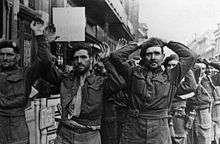
The Germans overcame pockets of resistance throughout the day, gaining control of the northern bridge approaches and permitting reinforcements to cross the span and reinforce units further south near Nijmegen. The remaining British troops continued to fight on, some with just fighting knives but by early Thursday morning almost all had been taken prisoner. The last radio message broadcast from the bridge – "Out of ammo, God save the King" – was heard only by German radio intercept operators.
While it was estimated that the 1st Airborne Division, 10,000 strong, would only need to hold the Arnhem bridge for two days, 740 had held it for twice as long against far heavier opposition than anticipated. While 81 British soldiers died defending Arnhem bridge, German losses cannot be stated with any accuracy, though they were high; 11 units known to have participated in the fighting reported 50% casualties after the battle. In memory of the fighting there, the bridge has been renamed the "John Frost Bridge".
Oosterbeek

Further west, the remnants of the 1st Airborne Division were gathering at Oosterbeek for their last stand; those already there were not seriously challenged by the enemy that day. To the east of the village, the 1st, 3rd and 11th Parachute Battalions and the 2nd South Staffordshires were organized into a defensive position. In desperate fighting later in the day, they repulsed an enemy attack which threatened to cut the division off from the Rhine and seal the fate of the bridgehead.
In the woods to the west of Oosterbeek the 4th Parachute Brigade fought its way towards the divisional perimeter but was attacked by German troops supported by artillery, mortars and tanks, (some mounting flame-throwers). The brigade had many casualties and the 10th Battalion reached Oosterbeek in the early afternoon with only 60 men.
In the rear, the 156th Parachute Battalion fought off numerous enemy attacks before counter-attacking; the Germans did not know they were fighting men who were in full retreat. The battalion, down to 150 men, mounted a bayonet charge to capture a hollow in the ground in the woods where they were pinned down by enemy attacks for the next eight hours. Towards the end of the day, 75 men fixed bayonets, broke through the German lines and retreated to the Allied pocket at Oosterbeek.
Nijmegen

The US 82nd did not drop men on both sides of the Nijmegen bridge: all troops were dropped on the south side of the Waal river. General Gavin of the US 82nd had a plan with no means to seize the Nijmegen bridge other than by frontal assault from the south. As the 82nd did not take boats with them, the boats requested from XXX Corps arrived in the afternoon, not the morning. The only boats available were canvas Bailey bridge engineers boats. A hasty daylight assault crossing was ordered. At about 15:00, the 3rd Battalion, 504th PIR, commanded by Major Julian Cook, began the river assault across the Waal. The American paratroopers were rowed across the Waal by members of 82nd Airborne Division C/307th Engineer Battalion in 26 canvas bridge engineers boats.[141] A shortage of paddles required some troopers to paddle the craft with rifle butts. About half the boats survived the crossing under heavy fire with eleven surviving the first two crossings. Before the day was over, C/307th crossed the Waal five times while ferrying across two battalions of the 504th.[142] The surviving paratroopers then proceeded to the village of Lent on the far bank to the north end approach road to the bridge. The costly attack was nicknamed "Little Omaha" in reference to Omaha Beach. 200 paratroopers were killed, while German losses exceeded 267. [143] German forces withdrew from both ends of the bridge after XXX Corps' Irish Guards tanks secured the bridge, supported by elements of the 505th Parachute Infantry Regiments from the south at 19:30, D+4. The 504th Parachute Infantry Regiment met The Irish Guard's tanks at Lent 1 km north of the bridge.
British Army officer Robert Kershaw interviewed 10th SS Panzer Division commander Heinz Harmel in the 1980s for his book "It Never Snows In September".[144] Harmel stated:
The four panzers (Carrington's Grenadier tank troop) who crossed the bridge made a mistake when they stayed in the village of Lent. If they had carried on their advance, it would have been all over for us.[145]
In the hardback version of the book Kershaw has a copy of Harmel's artillery map which shows German troops between Nijmegen and Arnhem were extremely thin, a handful of security pickets with rifles at the Betuwe midpoint in Elst. By 22:00, D+4 Frost and Hibbert had been overrun at the Arnhem bridge, 7 miles (11 km) away. However Harmel never mentioned it was dark by the time the Guards tanks reached the village of Lent meeting the 82nd troops.[146] Harmel also did not know, and never mentioned, that three Tiger tanks, one heavy gun and two companies of infantry were heading south from Arnhem to Lent, as the Guards tanks crossed the Nijmegen bridge.[147]
Sergeant Peter Robinson, of the Guards Armoured Division who led the charge in his tank over the Nijmegen road bridge stated:
The Nijmegen bridge wasn’t taken [by the 82nd] which was our objective. We reached the far end of the bridge and immediately there was a roadblock. So the troop sergeant covered me through and then I got to the other side and covered the rest of the troop through. We were still being engaged; there was a gun in front of the church three or four hundred yards in front of us. We knocked him out. We got down the road to the railway bridge; we cruised round there very steady. We were being engaged all the time.[148]
Initially four tanks crossed the bridge with a high probability some of the German explosive charges for demolition would activate. British engineers had cut some charges on the south of the bridge. As the tanks moved over the bridge they were fired on by Panzerfausts, and had grenades dropped on them by German troops in the bridge girders – 180 German bodies were recovered from the girders with some unaccounted falling into the river below. Once across the bridge only a few 82nd troops met the first tanks as they crossed the bridge. After crossing the bridge one tank was destroyed and another badly damaged, yet moving, and was driven to the village of Lent on the north side of the bridge by the only survivor of the attack – a Sgt Knight – who feigned being dead. The rest of the crews were killed, injured, and taken prisoner. One tank destroyed a German Sturmgeschütz assault tank lying in wait. The Guards tanks met the bulk of the 82nd troops north of the bridge in the village of Lent, 1 km north of the bridge and in darkness, after clearing out SS troops from the village and setting the church ablaze. On the road out of Lent, on the northern side of the railway bridge, the leading tank met two hidden German anti-tank guns in darkness. Even if the guns were located and destroyed, German troops with Panzerfausts were on the road and four available Guards tanks were low on ammunition. Only one of the four available tanks was a Firefly, mounting a gun capable of destroying a Tiger tank. Three Tiger tanks were heading south to Lent, unbeknownst to the Guards tank crews. Unable to locate the anti-tank guns, the tanks stopped.[147]
The Germans were still threatening the northern end of the bridge. Many of the Guards tanks were unavailable to run north over the bridge still assisting the 82nd and XXX Corps troops in Nijmegen. The Guards who were over the bridge could not leave the northern end of the bridge for fear of recapture. At Lent only 5 tanks were available including the damaged tank, which took on some 82nd troops as tank crew who in previous service had driven Sherman tanks. For the night this tank had a British and American crew. One tank, manned by Capt Lord Carrington, was stationed at the northern end of the bridge alone for 45 minutes, waiting for XXX Corps infantry relief who were fighting Germans in the girders as they moved across the bridge. The tank was attacked by the Germans with a Panzerfaust. After clearing the bridge of Germans in the girders, the Irish Guards crossed the bridge positioning a defence line. The line was reinforced with 82nd troops.[149][150]
To the east, German attacks on the Groesbeek Heights made significant progress. A counterattack at Mook by elements of the 505th PIR and 1st Battalion, the Coldstream Guards of XXX Corps forced the Germans back to their line of departure by 20:00. The 508th PIR lost ground at Im Thal and Legewald, when attacked by German infantry and tanks. To the south, running battles between the 101st and various German units continued. Eventually several tanks and self-propelled guns managed to cut the roads but pulled back when low on ammunition.
Day 5: Thursday, 21 September
Oosterbeek
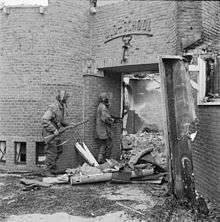
Approximately 3,584 survivors of the 1st Airborne Division established themselves in the buildings and woods around Oosterbeek with the intention of holding a bridgehead on the north side of the Rhine until XXX Corps could arrive. Throughout the day their position was heavily attacked on all sides. In the southeast, Lonsdale Force (the remnants of the 1st, 3rd, and 11th Parachute Battalions and 2nd South Staffordshires) repulsed a big attack aided by the fire of the divisional light artillery. In the north the 7th King's Own Scottish Borderers were almost overrun during the afternoon but a counterattack with bayonets restored the situation and the heavily depleted battalion moved further south to occupy a narrower front. The most serious attack of the day was made at dawn against "B" Company, 1st Battalion, Border Regiment which controlled a vital area of high ground in the southwestern tip of the perimeter overlooking the Heveadorp ferry crossing at Driel, which was the division's only straightforward means of receiving reinforcements from the south. The company was attacked by enemy infantry and armour, including captured French tanks equipped with flamethrowers, and the heights were lost. Counterattacks failed and the remnants of the company were redeployed. The division was left in a precarious position, controlling just 700 metres (770 yards) of the riverbank. The division held ground to similar attacks elsewhere on their front.
A supply attempt by RAF Stirlings of 38 Group was disrupted by the only Luftwaffe fighter interception during the operation. Fw 190s intercepted the Stirlings at low altitude and shot down 15. Anti-aircraft fire accounted for 8 further losses. The Fw 190s were able to penetrate the screen of Allied fighters sent to cover the drop when the U.S. 56th Fighter Group was late in arriving in its patrol sector between Lochem and Deventer. The 56th redeemed itself to an extent by shooting down 15 of the 22 Fw 190s as they departed.[151]
Remainder of Polish paratroopers enter the battle
After two days of delay due to the weather, the remainder of the Polish 1st Independent Parachute Brigade under Major-General Stanislaw Sosabowski entered the battle on the afternoon of 21 September, delivered at about 17:15 by 114 C-47s of the U.S. 61st and 314th Troop Carrier Groups. Two of the brigade's three battalions were dropped amidst heavy German fire, opposite the 1st Airborne Division's position on a new drop zone south of the Rhine near the village of Driel. The third battalion was dropped 12–15 miles away near Grave. Overall, the poor coordination by the British air transfer officers and persistent attacks by Luftwaffe aircraft caused their supplies to be dropped 15 km (9.3 mi) away on the opposite side of the Rhine.
Intending to use the Heveadorp ferry to reinforce the division, they discovered that the opposite bank was dominated by the enemy and that the ferry was missing; it was later found downstream past the road bridge, completely unserviceable. Unable to help the British, the Polish withdrew to Driel for the night and organised defence there, with the Rhine behind their backs and German units increasing in strength around them. The brigade had lost 25% of its fighting strength, amounting to 590 casualties. Several attempts to cross the Rhine on improvised equipment could only be partly successful due to heavy German fire and inability by the 1st Airborne to secure the landing area on the Rhine's northern bank. The 1st Airborne Division made radio contact during the day with guns of the 64th Medium Regiment of XXX Corps' artillery which had advanced with the ground forces and were assigned to the division for support. Unlike many others, this radio link worked throughout the battle and the regiment provided valuable fire support to the division.
Nijmegen
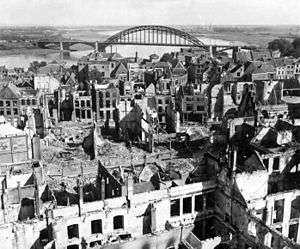
Despite the capture of Nijmegen bridge and the clearing of the town on the previous evening, the five tanks of Guards Armoured Division which were across the river did not advance due to: darkness, one tank having been hit, meeting hidden German anti-tank guns, not knowing the full situation on the road ahead and having to secure the northern end of the bridge until infantry were fully in place. Unbeknown to the leading tank crews, three Tiger tanks and two companies of infantry were heading down the road south from Arnhem to Lent. The Division resumed its advance about 18 hours later, at noon in daylight with reinforcements from Nijmegen.[152]
Horrocks claimed he needed to hold his force as his troops were still fighting in Nijmegen and supplies were slow coming up the single road from Belgium. The Coldstream Guards Group were repulsing an attack on the Groesbeek position, the Irish Guards Group had moved back south to Eindhoven to meet another attack, the Grenadiers had just captured the approaches to the bridge with assistance by the 82nd Airborne paratroops and had five tanks across to support securing the north end of the bridge, and the Welsh Guards were in reserve for the 82nd Airborne. The Guards Armoured Division was scattered over 25 square miles of the south bank of the Waal.[146] Horrocks stated, "Jim Gavin, the divisional commander, could have had no idea of the utter confusion that reigned in Nijmegen at the time, with sporadic battles going on all over the place, and particularly on our one road to the rear where chaos reigned".[153]
The Market Garden plan depended upon a single highway as the route of advance and supply. This imposed a delay, although the delay was not that great. A problem was that other units could not be deployed on other routes to maintain momentum. Brigadier General Gavin's diary comment was:
Had Ridgeway been in command at that moment, we would have been ordered up that road in spite of all our difficulties, to save the men at Arnhem.[154]
Gavin is silent on the 36-hour delay caused by his failure to capture the bridge on schedule. The historian Max Hastings wrote:
It reflected poorly on the British Army....
In another version of events, Robin Neillands quotes Carrington:
"I certainly met an American officer ... the Airborne were all very glad to see us and get some support; no one suggested we should press on to Arnhem.". Neillands went on, "Let us be frank. The 82nd should have taken the Nijmegen bridge on D-Day, 17 September. By failing to do so Gavin made a major contribution to the failure of the entire Arnhem operation and it will not do to pass the blame for that failure on to the British or to Captain Lord Carrington."[155]
The delay enabled the Germans to reinforce the defence already established at Ressen (an SS infantry battalion, eleven tanks, an infantry battalion, two 88 mm batteries, twenty 20 mm flak and the remnants of the forces fighting at Arnhem, aided by use of the bridge following their capture of its northern end.[156] The advance of the Guards, hindered by marshes that prevented off-road movement, was soon halted by a firm German defensive line. The Guards spearhead did not have the strength to outflank the line. The 43rd Division was ordered to take over the lead, work its way around the enemy positions and make contact with the Polish airborne troops at Driel to the west. The 43rd was 16 km (9.9 mi) away and there was a traffic jam between them and Nijmegen. It was not until the following day, Friday, that the whole division crossed the River Waal and began its advance.
The Germans, clearly starting to gain the upper hand at Arnhem, continued counterattacking all along the path of XXX Corps. XXX Corps still managed to advance with the 101st Airborne Division and XXX Corps holding ground. Glider tugs and cargo carriers delivered supplies to the 82nd Airborne Division. About 60% of the supplies were recovered with 351 of the gliders being counted as effective, partly with the help of Dutch civilians. Most of the 82nd and 101st, reinforced with British armoured units, were engaged in defensive fighting with the objective of holding the highway corridor. Small engagements were fought along the whole length of the corridor.
Day 6: Friday, 22 September ("Black Friday")
The Germans, wary after unsuccessful and costly attacks the previous day, shelled and mortared the airborne positions heavily. By the end of the battle some 110 guns had been brought to Oosterbeek as the Germans shifted to the tactics that had worked so well at Arnhem bridge. Attacks were limited, conducted against specific positions and even individual houses. Numerous well-sited British anti-tank guns also caused German reluctance to attack. The survivors of the 1st Airborne were outnumbered 4 to 1. The Polish 1st Parachute Brigade at Driel, unable to cross the Rhine, nonetheless forced a redeployment of German forces. Fearing a Polish attempt to recapture Arnhem bridge or, worse, an attempt to cut the road to the south and so trap the 10th SS Panzer Division then blocking the route of the Guards Armoured Division to Arnhem, the Germans withdrew 2,400 troops from Oosterbeek. They were moved south of the river to engage the Polish paratroopers at Driel, making attacks to little effect through the day.
Link-up between the Poles and XXX Corps
The fog lifted as leading elements of the 43rd Division attempted to advance to Driel, exposing them to German fire. They arrived in Driel during the evening. Lacking assault craft, an unsuccessful attempt was made that night to put elements of the Polish brigade across the river. British and Polish engineers on both sides of the Rhine had worked through the day to improvise a crossing using small boats linked by signals cable but the cable kept breaking forcing the Polish troops to slowly row across against the strong current. The attempt was made under enemy observation and fire and only 52 soldiers of the 8th Polish Parachute Company survived the crossing before a halt was called at dawn.
While much of the corridor was firmly in Allied hands, German counterattacks were still being mounted along its length. During the previous night, two mixed armoured formations on either side of Highway 69 attacked between Veghel and Grave; one group managed to cut the highway and prevent any further advance to Arnhem.
Day 7: Saturday, 23 September
The Germans had figured out what the Poles were attempting to do and they spent the rest of the day trying to cut off the British in their northern bridgehead from the riverside. The British managed to hold on and both sides suffered heavy losses. The Germans also attacked the Poles on the south side in order to tie them down but several tanks arrived from XXX Corps and the German attack was defeated. Boats and engineers from the Canadian army also arrived that day and another river crossing that night landed 150 troops of the Polish 3rd Parachute Battalion on the north bank of the Rhine.
To the south several more German attacks from their position astride the road were stopped but the road was still cut. XXX Corps then sent a unit of the Guards Armoured Division 19 km (12 mi) south and re-took the road. The rest of the force to the north continued to wait for infantry to move up, still only a few kilometres south of Arnhem.
The 325th GIR was finally delivered to reinforce the 82nd Airborne, originally planned for 19 September, and while it was immediately 75% effective, arrived far too late to affect the battle in that sector.
Day 8: Sunday, 24 September
Another German force cut the road to the south of Veghel and set up defensive positions for the night. It was not clear to the Allies at this point how much of a danger this represented but the principal objective of Operation Market Garden, i.e. the Allied crossing of the Rhine, was abandoned this day and the decision made to go over to the defensive with a new front line in Nijmegen. Nonetheless, an attempt was made on Sunday night to reinforce the 1st Airborne Division with the 4th Battalion, The Dorsetshire Regiment. Two companies were put across the river but the location of the crossing point was ill-advised and the Dorsets landed among German positions. Fragmented by their landing and immediately pinned down, of the 315 men who crossed only 75 reached Oosterbeek; the remainder were taken prisoner. As a result of this failure, it was decided to withdraw the 1st Airborne Division from its bridgehead on the northern side of the Rhine.
Day 9: Monday, 25 September
At dawn the 1st Airborne Division received their orders to withdraw across the Rhine; this was called Operation Berlin. This could not be done until nightfall and in the meantime the division struggled to survive. In a departure from their cautious attritional tactics of the previous days, the Germans formed two potent SS battlegroups and made a significant thrust along a narrow front in the eastern sector. This succeeded in breaking through the thin front line and for a time the division was in peril. The attack met with increasing resistance as it pushed deeper into the British lines and was finally broken up by a heavy bombardment of the 64th Medium Regiment.
Employing every ruse to give the Germans the impression that their positions were unchanged, the 1st Airborne Division began its withdrawal at 22:00. British and Canadian engineer units ferried the troops across the Rhine, covered by the Polish 3rd Parachute Battalion on the north bank. By early the next morning they had withdrawn 2,398 survivors, leaving 300 men to surrender on the north bank at first light, when German fire prevented their rescue.[157] Of approximately 10,600 men of the 1st Airborne Division and other units who fought north of the Rhine, 1,485 had died and 6,414 were taken prisoner of whom one third were wounded.
To the south the newly arrived 50th (Northumbrian) Infantry Division attacked the Germans holding the highway and secured it by the next day. Allied positions in the Nijmegen Salient as it came to be known, were manned throughout the rest of September and October by airborne units, then handed over to the First Canadian Army in November 1944 and remained unchanged until February 1945 when Operation Veritable was launched on the Rhineland, advancing east instead of north towards Arnhem.
Casualties

XXX Corps suffered fewer than 1,500 casualties, which stands in stark contrast to the 8,000 casualties suffered by the 1st Airborne Division. On several occasions, units of the flanking British Corps made contact with paratroopers before units of XXX Corps, and fought on to support them until the end of the operation. The higher toll by the 101st Airborne Division reflects the reality that aside from contending with the local German defenders, they also had to combat German troops retreating from the XXX Corps advance.
| Casualties | Total | Grand Total |
|---|---|---|
| Dutch civilians | 500[lower-alpha 11] | 500 |
| Second Army and I Airborne Corps |
11,784–13,226[lower-alpha 12] | 15,326–17,200 |
| XVIII Airborne Corps | 3,542–[159] 3,974[158][lower-alpha 13] |
German casualties are harder to determine, as the records are incomplete. The official casualties estimated by Rundstedt were 3,300 but this was challenged by historians. Conservative estimates range from 6,400 to 8,000.[161][162] Kershaw lists the German order of battle and put casualties at 6,315–8,925 German casualties.[163] On A Bridge Too Far by Cornelius Ryan, he estimated 7,500 to 10,000 more German casualties to those of Rundstedt. A final 10,800–13,300 losses.[164] A contemporary paper of the 21st Army Group mentions that 16,000 German prisoners were taken during Operation Market Garden but it is unclear how those numbers relate to later casualty estimates.[13][lower-alpha 14]
Honours
Victoria Cross
A total of five Victoria Crosses were awarded during Operation Market Garden. On 19 September, RAF Douglas Dakota Mk. III, KG374, c/n 12383, (ex-USAAF C-47A-DK, 42-92568), 'YS-DM', of 271 Squadron, RAF Down Ampney, Gloucester, piloted by F/Lt. David Lord, was hit by anti-aircraft fire in the starboard engine while on a supply sortie to Arnhem. Fire spread over the starboard wing, as Lord spent ten minutes making two passes over very small drop zones (which, unknown to the crew, had been overrun by German forces) to drop eight ammunition panniers. Just after the last pannier was dropped, the fuel tank exploded and tore off the wing, and only the navigator F/O Harry King escaped. He was made a POW the following morning, spending the rest of the war in Stalag Luft I at Barth, Germany. Lord, the second pilot P/O R. E. H. "Dickie" Medhurst (son of Air Chief Marshal Sir Charles Medhurst), the wireless operator F/O Alec Ballantyne, and air dispatchers Cpl. P. Nixon, Dvr. A. Rowbotham, Dvr. J. Ricketts, and Dvr. L. Harper of 223 Company RASC, were killed. Following the release of King from prison camp, full details of the action became known and Lord received a posthumous Victoria Cross on 13 November 1945, the only VC awarded to any member of Transport Command during World War II. In May 1949, the Dutch Government awarded Harry King the Netherlands Bronze Cross.[165]
From 17 to 20 September, John Hollington Grayburn of the 2nd Parachute Battalion "led his men with supreme gallantry and determination. Although in pain and weakened by his wounds, short of food and without sleep, his courage never flagged. There is no doubt that, had it not been for this officer's inspiring leadership and personal bravery, the Arnhem bridge could never have been held for this time."[166] John Grayburn's posthumous award of the Victoria Cross was accompanied by his posthumous promotion to captain.[167]
Also on 19 September, Captain Lionel Queripel of the 10th Parachute Battalion, though injured in the face and both arms, personally remained as a solitary rear guard after ordering his men to withdraw, over their protests. He was awarded a posthumous Victoria Cross.
On 20 September, Lance Sergeant John Baskeyfield's "superb gallantry [was] beyond praise. During the remaining days at Arnhem stories of his valour were a constant inspiration to all ranks. He spurned danger, ignored pain and, by his supreme fighting spirit, infected all who witnessed his conduct with the same aggressiveness and dogged devotion to duty which characterised his actions throughout."[168] Sergeant Baskeyfield, a member of the 2nd Battalion, South Staffordshire Regiment, posthumously received his Victoria Cross.
On 25 September, Major Robert Henry Cain, also of the 2nd Battalion, South Staffordshire Regiment, "showed superb gallantry. His powers of endurance and leadership were the admiration of all his fellow officers and stories of his valour were being constantly exchanged amongst the troops. His coolness and courage under incessant fire could not be surpassed."[169] Major Cain was the only Victoria Cross recipient to survive the battle.[170]
Medal of Honor
Two American soldiers received the Medal of Honor, both posthumously. On 19 September, Private First Class Joe E. Mann of the 101st Airborne Division, under attack and injured in both arms, "which were bandaged to his body... yelled "grenade" and threw his body over the grenade, and as it exploded, he died."[171]
On 21 September, Private John R. Towle of the 82nd Airborne Division, under attack and "motivated only by his high conception of duty ... rushed approximately 125 yards through grazing enemy fire to an exposed position from which he could engage [an] enemy half-track with his rocket launcher. While in a kneeling position preparatory to firing on the enemy vehicle, Pvt. Towle was mortally wounded by a mortar shell. By his heroic tenacity, at the price of his life, Pvt. Towle saved the lives of many of his comrades and was directly instrumental in breaking up the enemy counterattack."[172]
Aftermath
Debate on Allied strategy and tactics
Operation Market Garden has remained a controversial battle for several reasons.
Allied tactics and strategy have been much debated. The operation was the result of a strategy debate at the highest levels of Allied command in Europe. Much post-war analysis has thus probed the alternatives that were not taken, such as giving priority to securing the Scheldt estuary and so opening the port of Antwerp. But Montgomery insisted that the First Canadian Army should clear the German garrisons in Boulogne, Calais and Dunkirk first although the ports were damaged and would not be navigable for some time. Admiral Cunningham warned that Antwerp would be "as much use as Timbuktu" unless the approaches were cleared, and Admiral Ramsay warned SHAEF and Montgomery that the Germans could block the Scheldt Estuary with ease.[173] The (French) Channel ports were "resolutely defended" and Antwerp was the only solution. But the Germans reinforced their island garrisons, and the Canadians "sustained 12,873 casualties in an operation which could have been achieved at little cost if tackled immediately after the capture of Antwerp. .... This delay was a grave blow to the Allied build-up before winter approached."[31]
Optimistic planning
Among the controversial aspects of the plan was the necessity that all the main bridges be taken. The terrain was also ill-suited for the mission of XXX Corps.[75] Brereton had ordered that the bridges along XXX Corps' route should be captured with "thunderclap surprise".[174] It is therefore surprising in retrospect that the plans placed so little emphasis on capturing the important bridges immediately with forces dropped directly on them. In the case of Veghel and Grave where this was done, the bridges were captured with only a few shots being fired.
The decision to drop the 82nd Airborne on the Groesbeek Heights, several kilometres from the Nijmegen Bridge, has been questioned because it resulted in a long delay in its capture. Browning and Gavin considered holding a defensive blocking position on the ridge a prerequisite for holding the highway corridor. Gavin generally favoured accepting the higher initial casualties involved in dropping as close to objectives as possible in the belief that distant drop zones would result in lower chances of success. With the 82nd responsible for holding the centre of the salient, he and Browning decided the ridge must take priority. Combined with the 1st Airborne Division's delays within Arnhem, which left the Arnhem bridge open to traffic until 20:00, the Germans were given vital hours to create a defence on the Nijmegen bridge.
At Arnhem, the RAF planners selected the drop zones, refusing to drop near the town on the north side of the target bridge because of flak at Deelen. Another suitable drop zone just to the south of the bridge was rejected because it was thought to be too marshy for landing gliders containing the force's heavy equipment. However, that same drop zone was selected for the 1st Polish Brigade in the third lift, which suggests they were well aware of its suitability. Urquhart made his objections to the RAF planners, who were unmoved, even when he informed them that the troops and glider pilots were willing to take whatever risks landing closer to the objectives entailed. Urquhart made the best of the RAF planners' decision and thus the three main landing and drop zones were 8–10 km (5.0–6.2 mi) from the bridge, with the fourth being 13 km (8.1 mi) away.[175][176]
Weather
A precarious timetable at the mercy of the weather resulted in the 101st Airborne Division being without its artillery for two days, the 82nd Airborne without its artillery for a day and without its glider infantry regiment for four days, and the British 1st Airborne Division without its fourth brigade until the fifth day. The more time required to complete the air drops, the longer each division had to devote forces to defending the drop and landing zones, weakening their offensive power.
Priority of operation
Several weeks prior to the plan taking shape, the British had captured Antwerp and its all-important port facilities. This action had the potential to greatly shorten the Allies' supply lines and trap Gustav-Adolf von Zangen's 15th Army of 80,000 men on the south side of the Scheldt Estuary. Instead, Von Zangen's men, with most of their heavy equipment including their artillery, escaped by boat to South Beveland peninsula (Zeeland province, the Netherlands). In September, the peninsula could have been sealed by a short advance of only 24 km (15 mi) past Antwerp. Instead, because priority on supplies went to Market Garden, the First Canadian Army paused at Antwerp and then fought the costly Battle of the Scheldt in October. In the aftermath of Market Garden, Antwerp was not made operational until 28 November. By 1 October, over 240 Allied supply ships were waiting, unable to unload their cargo because of the limited port facilities on the continent.
Missed opportunities
Arnhem bridge was not the only Rhine crossing. Had the Market Garden planners realized that a ferry was available at Driel, the British might have secured that instead of the Arnhem bridge. Being a shorter distance away from their western drop and landing zones, the 1st Parachute Brigade could have concentrated to hold the Oosterbeek heights, instead of one battalion farther away at the road bridge; in this case, Arnhem was "one bridge too many". A contrasting view is that the attack into Arnhem was intended to capture the rail bridge, the pontoon bridge and the road bridge; that the rail bridge was blown in the face of Frost's 2nd Parachute Battalion, the pontoon bridge had been disabled by the removal of several sections and that this left only the highway bridge intact; the Heveadorp ferry was no substitute for a bridge.[177]
Hypothetically, had XXX Corps pushed north, they might have arrived at the south end and secured it (had the Guards Armoured sent more than five Sherman tanks across the bridge at Nijmegen and had they not been later stopped by the German position at Ressen), leaving the way open for another crossing to the north at some other point. There was the smaller possibility of arriving with Frost's force intact. This perceived "lack of guts" caused some bitterness at the time among members of both the British 1st Airborne and the U.S. 82nd Airborne. As it was, XXX Corps did not resume the drive to Arnhem that night, but rather eighteen hours later.
The commander of XXX Corps advocated another course of action. About 25 km (16 mi) to the west was another bridge at Rhenen, which he predicted would be undefended, because of all the efforts being directed on Oosterbeek. This was true, but the corps was never authorised to take the bridge; if it had, it is almost certain they would have crossed unopposed into the rear of the German lines. By this time, it appears that Montgomery was more concerned with the German assaults on Market Garden's lengthy "tail".
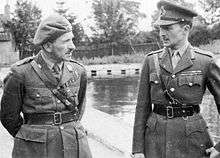
Bad choices were made throughout the operation, and opportunities were ignored. The commander of the Glider Pilot Regiment had asked for a small force with gliders to land on the southern side of the bridge at Arnhem to quickly capture it, but he was denied. This was surprising in light of the fact that in Normandy, the British 6th Airborne Division had used such coup-de-main tactics to take the Pegasus Bridge. In Britain, the commander of the British 52nd (Lowland) Infantry Division, whose troops were slated to fly into a captured airfield, pleaded with his superiors to allow a brigade to fly in with gliders to assist Major-General Urquhart's trapped forces.[178] Browning declined the offer, "as situation better than you think" and reaffirmed his intention to fly the 52nd Division into Deelen airfield as planned.[179] This was probably fortunate, as glider landings on undefended landing zones before the eyes of an alert enemy could have resulted in catastrophe. There was another airfield near Grave and the 52nd Lowland could have been landed there, as the 1st Light Antitank Battery did on 26 September.[180] The Polish 1st Parachute Brigade commander Sosabowski, was prepared to try a dangerous drop through the fog which held up his deployment but again was refused.
Market Garden was a risky plan that required a willingness to gamble at the tactical and operational levels. Unfortunately, the detailed planning and leadership required at those levels was not always present. The 1st Airborne Division, the least experienced in working as a whole division, was given the most difficult objective. In Beevor's view this reflected both the British desire to continue to be seen as an equal partner of the US in the war effort and the fact that US opinion would no longer stand for American troops being placed in the most risky position under British command. As such it represented the triumph of political necessity over the military reality that by this point (unlike in North Africa) US forces were better battlefield performers than the exhausted and over-stretched British [181].
The failure of the 82nd Airborne Division to attach maximum importance to the early capture of Nijmegen Bridge was a major mistake. XXX Corps was also criticized for its inability to keep to the operation's timetable. The most notable example being on Wednesday 20 September, when the Nijmegen Bridge had finally been captured and elements of the Guards Armoured Division, after crossing, promptly came to a halt for the night to rest, refuel, and rearm. XXX Corps was delayed at Son by a bridge demolition, and again at Nijmegen (having arrived by D+3, within the maximum time estimate, having compensated for the delay to build a Bailey Bridge at Son). The lead unit of XXX Corps, the Guards Armoured Division, was led by a commander (Allan Adair) whom Montgomery had sought to remove prior to D-Day. This action was blocked due to Adair's popularity. Gavin regretted giving his division's most important tasks (Groesbeek ridge and Nijmegen) to the 508th PIR rather than his best regiment, Tucker's 504th PIR.
Intelligence failure
Unlike the American airborne divisions in the area, British forces at Arnhem ignored the local Dutch resistance. There was a reason for this: Britain's spy network in the Netherlands had been thoroughly and infamously compromised – the so-called England game, which had only been discovered in April 1944, therefore British intelligence took pains to minimise all civilian contact. U.S. units, without this bad experience, made use of Dutch help. As things turned out, knowledge of the Driel ferry or of the underground's secret telephone network could have changed the result of the operation, especially since Allied radio equipment failed, having to rely on messengers. The latter would have given the XXX Corps and Airborne High Command knowledge about the dire situation at Arnhem.
After the war, claims arose that the Dutch resistance had indeed been penetrated. One high-ranking Dutch officer who had worked in counter-intelligence at SHAEF, Lieutenant-Colonel Oreste Pinto published a popular book, Spy Catcher, part-memoir and part counter-intelligence handbook. Pinto, who had made a name for himself in World War I for his part in uncovering Mata Hari, claimed that a minor figure in the Dutch resistance, Christiaan Lindemans (nicknamed "King Kong") had been a German agent and had betrayed Operation Market Garden to the Germans.[182] Lindemans was arrested in October 1944, but committed suicide in his cell in 1946, while awaiting trial. In 1969, the French journalist and historian Anne Laurens concluded that Lindemans had been a double agent.[183]
Tributes to the participants
Eisenhower wrote to Urquhart: "In this war there has been no single performance by any unit that has more greatly inspired me or more highly excited my admiration, than the nine days action of your division between 17 and 26 September".[184]
Montgomery predicted that "in years to come it will be a great thing for a man to be able to say: 'I fought at Arnhem'."[185]
CBS war correspondent Bill Downs, who was assigned to Montgomery's campaign since the Normandy invasion, famously said of Nijmegen that it was "...a single, isolated battle that ranks in magnificence and courage with Guam, Tarawa, Omaha Beach...a story that should be told to the blowing of bugles and the beating of drums for the men whose bravery made the capture of this crossing over the Waal River possible."[186]
Controversy
The operation and the planning are still controversial. Both Churchill and Montgomery claimed that the operation was nearly or 90% successful, although in Montgomery's equivocal acceptance of responsibility he blames lack of support, and also refers to the Battle of the Scheldt which was undertaken by Canadian troops not involved in Market Garden.
Winston Churchill claimed in a telegram to Jan Smuts on 9 October that
As regards Arnhem, I think you have got the position a little out of focus. The battle was a decided victory, but the leading division, asking, quite rightly, for more, was given a chop. I have not been afflicted with any feeling of disappointment over this and am glad our commanders are capable of running this kind of risk. [The risks] were justified by the great prize so nearly in our grasp...Clearing the Scheldt estuary and opening the port of Antwerp had been delayed for the sake of the Arnhem thrust. Thereafter it was given first priority[187]
In 1948, Eisenhower wrote that "The attack began well and unquestionably would have been successful except for the intervention of bad weather."[188] Eisenhower was isolated in the SHAEF HQ at Granville, which did not even have radio or telephone links, so his staff were largely ignorant of the details of the operation. Bedell Smith's objections were brushed aside by Montgomery, as were those of Montgomery's chief of staff Freddie de Guingand who went to England on sick leave.
Responsibility for the failure "began with Eisenhower and extended to Montgomery, Brereton, Browning, and, on the ground side, Dempsey and Horrocks, neither of whom ... galvanised their tank units while there was still time to have seized and held Arnhem bridge". D'Este notes that Montgomery's admission of a mistake was unique: "the only admission of failure by a senior Allied commander".[189]
Montgomery claimed that Market Garden was "90% successful" and said:
It was a bad mistake on my part – I underestimated the difficulties of opening up the approaches to Antwerp ... I reckoned the Canadian Army could do it while we were going for the Ruhr. I was wrong ... In my – prejudiced – view, if the operation had been properly backed from its inception, and given the aircraft, ground forces, and administrative resources necessary for the job, it would have succeeded in spite of my mistakes, or the adverse weather, or the presence of the 2nd SS Panzer Corps in the Arnhem area. I remain Market Garden's unrepentant advocate.[190]
"My country can never again afford the luxury of another Montgomery success," stated Bernhard, the Prince of the Netherlands.[191]
Subsequent combat in the Netherlands
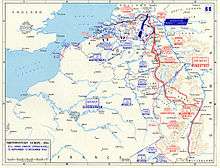
After Operation Market Garden failed to establish a bridgehead across the Rhine, Allied forces launched offensives on three fronts in the south of the Netherlands. To secure shipping to the vital port of Antwerp they advanced northwards and westwards, the Canadian First Army taking the Scheldt Estuary in the Battle of the Scheldt.[192] Allied forces also advanced eastwards in Operation Aintree to secure the banks of the Meuse as a natural boundary for the established salient. This attack on the German bridgehead west of the Meuse near Venlo was for the Allies an unexpectedly protracted affair, which included the Battle of Overloon.[193] After Aintree's completion Operation Pheasant was launched on 20 October which saw the Market Garden salient expand Westward and resulted in the liberation of 's-Hertogenbosch.
In February 1945, Allied forces in Operation Veritable advanced from the Groesbeek heights which had been taken during Market Garden, and into Germany,[194] crossing the Rhine in March during Operation Plunder.[195] As a result of Operation Plunder, the city of Arnhem was finally liberated by I Canadian Corps on 14 April 1945 after two days of fighting.[196] A surrender of the remaining German forces in the west of the Netherlands was signed on 5 May.[197]
Famine in the Netherlands
A tragic consequence of the operation's failure was the Dutch famine of 1944–45. During the battle Dutch railway workers, incited by the Dutch government in London, went on strike in order to aid the Allied assault. In retribution Germany forbade food transportation, and in the following winter more than twenty thousand Dutch citizens starved to death.
Commemoration
Memorials and remembrance
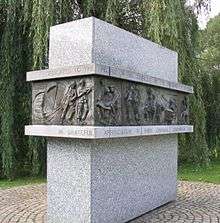
The prized Arnhem bridge for which the British had fought so hard did not survive the war. As the front line stabilised south of the Rhine, B-26 Marauders of 344th Bomb Group, USAAF destroyed it on 7 October to deny its use to the Germans.[198] It was replaced with a bridge of similar appearance in 1948 and renamed John Frost Bridge (John Frostbrug) on 17 December 1977.[199][200]
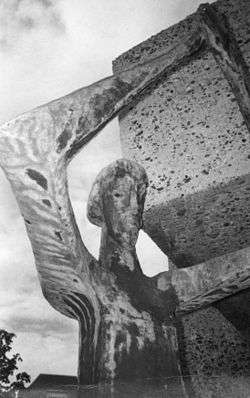
There are a number of monuments in the Arnhem area. A memorial near Arnhem reads
TO THE PEOPLE OF GELDERLAND
50 years ago British and Polish Airborne soldiers fought here against overwhelming odds to open the way into Germany and bring the war to an early end. Instead we brought death and destruction for which you have never blamed us.
This stone marks our admiration for your great courage, remembering especially the women who tended our wounded. In the long winter that followed your families risked death by hiding Allied soldiers and airmen, while members of the Resistance helped many to safety.
You took us into your homes as fugitives and friends,
We took you into our hearts.
This strong bond will continueLong after we are all gone.[201]
On 16 September 1994, 101st Airborne veterans unveiled a "Monument for the Dutch" in Sint-Oedenrode. The monument is a gift from the veterans to the civilians who fought alongside of the U.S. troops, much to the surprise and relief of the U.S. soldiers. The inscription on the monument is in English and reads "Dedicated to the people of the Corridor by the veterans of the 101st Airborne Division, in grateful appreciation of their courage, compassion and friendship".[202]
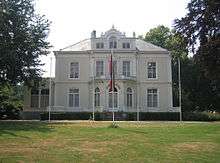
On 31 May 2006, Polish 1st Independent Airborne Brigade was awarded the Dutch Military William Order by HM Queen Beatrix for gallantry at Arnhem during Operation Market Garden in 1944.[203] The American 82nd Airborne Division had previously been awarded the same order for gallantry during the operation on 8 October 1945.
Several museums in the Netherlands are dedicated to Operation Market Garden, including the National Liberation Museum 1944–1945 in Groesbeek, Wings of Liberation Museum Park in Best (near Eindhoven) and Airborne Museum Hartenstein in Oosterbeek.[204][205][206] Annually there is a commemorative walk in Oosterbeek on the first Saturday of September which attracts tens of thousands of participants.
A Commemorative Project plaque was unveiled on 23 June 2009, to commemorate the unique military and historical ties between Canada and the Netherlands. A hole, a par five, on the south course (Hylands Golf Course Uplands) in Ottawa, Ontario was named "Arnhem, in honour of the Royal Canadian Artillery squadrons that took part in Second World War allied airborne Operation MARKET GARDEN from September 17 to 26, 1944. The operation, intended to secure a series of bridges so the allies could advance into Germany, fell short when the allied forces were unsuccessful in securing the bridge over the Rhine at Arnhem."[207] The village of Somerby in Leicestershire has a memorial hall dedicated to the men of the 10th battalion who were based there and who did not return. Each year there is a parade in their honour led by the Seaforth Highlanders.
In film
- Operation Market Garden was the subject of the 1946 film Theirs Is the Glory. This film mixed original footage from the battle with reenactments, shot on location in Arnhem. Many of the actors portraying the paratroopers were soldiers who fought in the battle. Some played themselves, including Kate ter Horst, Frederick Gough, John Frost, and Stanley Maxted, the Canadian journalist who posted gripping reports from the front at Arnhem.[208]
- A Bridge Too Far is a 1977 epic war film, based on the 1974 book of the same name by Cornelius Ryan. It was adapted by William Goldman, was directed by Richard Attenborough, and had an all-star cast. Unlike the earlier film, it covered the entire operation from all sides: British, American, German, Polish, and Dutch.
- Dramatizations of the actions of the 101st Airborne Division, 506th PIR during the battle (with cameo scenes also of XXX Corps, British paratroopers and Canadian engineers) formed part of the HBO television miniseries Band of Brothers.
References
Footnotes
- Dr. John C Warren wrote: "Thus ended in failure the greatest airborne operation of the war … All objectives save Arnhem had been won, but without Arnhem the rest were as nothing.[1]
- Montgomery said that "Had good weather obtained, there was no doubt that we should have attained full success".[2] [General] Student, when interrogated by Liddell Hart, did not go quite so far as this, but gave the weather as the main cause of the operation to be fully completed.[3] Chester Wilmot wrote: "Summing up the overall results of Market Garden … [Montgomery claiming 90% success] … This claim is difficult to support, unless the success of the operation is judged merely in terms of the numbers of bridges captured. Eight crossings were seized but the failure to secure the ninth, the bridge at Arnhem, meant the frustration of Montgomery's strategic purpose. His fundamental objective had been to drive Second Army beyond the Maas and Rhine in one bound."[4]
- While the size of the German force used to oppose Market Garden is currently unknown, Michael Reynolds notes that Fifteenth Army, based to the west of the axis of advance, contained over 80,000 men. The strength of First Parachute Army is not given. However, Reynolds notes it had just been reinforced with over 30,000 men from the Luftwaffe, including paratroopers in various stages of training. Finally, the 9th and 10th SS Panzer Divisions each contained in the neighborhood of 6,000–7,000 men.[8]
- XXX Corps lost 70 tanks while VIII and XII Corps lost c. 18 tanks.[9]
- Operation Varsity in 1945 involved more aircraft, gliders, and troops on D-Day than in Market, but troops flown in on later days made Market Garden the larger operation.[15]
- The CIGS, Field Marshal Sir Alan Brooke, was absent as he was attending the Second Quebec Conference
- "Handsup", a drop on Quiberon, was cancelled after naval objections and "Beneficiary", a drop on Saint-Malo, because defences were too strong.[58]
- After 25 August, IX TCC was removed from Ninth Air Force and placed directly under U.S. Strategic Air Forces.[58]
- 655 of the 700 scheduled RAF sorties on the first two days towed gliders and the RAF only dropped 186 total troops by parachute.[69]
- The 9th SS Panzer Division was organized into the divisional reconnaissance battalion and 19 Alarmheiten (Alarm Companies) trained to head towards the sound of gunfire, each being about 130 men.[93]
- Ryan claims civilian casualties in the Arnhem area are less than 500, while he had heard of up to 10,000 killed, wounded or displaced civilians in the Market Garden operation area.[158]
- According to Ellis Second Army casualties (excluding the 1st Airborne Division) amounted to 3,716 men from 17–26 September.[159] Ryan states that total British casualties amounted to 13,226: 1st Airborne Division (including Polish forces and glider pilots), 7,578; RAF pilot and crew losses, 294; XXX Corps, 1,480, while supporting operations by VIII and XII Corps resulted in 3,874 casualties.[158] VIII Corps staff place their losses at 663 men.[160] Michael Reynolds arrives at a slightly different figure to Ryan for the airborne losses; 1,446 men of the 1st Airborne and Glider Pilot Regiment were killed while 6,414 were taken prisoner. Furthermore 97 Poles were killed and a further 111 captured.[6]
- 82nd Airborne Division: 1,432. 101st Airborne Division: 2,118. Glider pilots and air crew: 424.[158]
- Historian Cornelius Ryan states that "complete German losses remain unknown but that in Arnhem and Oosterbeek admitted casualties came to 3,300 including 1,300 dead.... I would conservatively estimate that Army Group B lost at least another 7,500–10,000 men of which perhaps a quarter were killed."[158] Michael Reynolds wrote that "precise details of German casualties do not exist" they totalled about 6,400 based on research by Robert Kershaw. Kershaw estimates that 2,565 Germans were killed north of the lower Rhine and a further 3,750 were lost fighting around XXX Corps corridor.[161] Stephen Badsey states that "other calculations place [German losses] at 2,000 dead and 6,000 wounded".[162]
Citations
- Warren 1956, p. 146.
- Westwall 1945.
- Wilmot 1997, p. 525.
- Wilmot 1997, p. 523.
- The Dutch forces most involved in Market Garden were the Royal Netherlands Motorized Infantry Brigade (attached to British XXX Corps) and the Dutch resistance.
- Reynolds 2001, p. 173.
- Antony Beevor, 2020, Order of Battle: Operation Market Garden. (Access: 15 March 2020.)
- Reynolds 2001, pp. 100–01.
- MacDonald 1963, p. 199, and endnotes.
- MacDonald 1963, p. 199.
- "Operation Market Garden Netherlands 17–25 September 1944" (PDF). https://www.gov.uk/. External link in
|website=(help) - Reynolds 2001, pp. 173–74; Badsey 1993, p. 85; Kershaw 2004, pp. 339–40.
- Staff 1945, p. 32.
- The Battle for the Rhine 1944 by Robin Neillands, Chapter 4 The Road to Arnhem
- MacDonald 1963, p. 132.
- Memoirs of Field-Marshal Montgomery by Bernard Montgomery, Chapter 16 Battle for Arnhem
- The Battle for the Rhine 1944 by Robin Neillands, Chapter 5 Nijmegen
- Middlebrook 1995, pp. 64–65
- Chant, Chris (1979). Airborne Operations. An Illustrated Encyclopedia of the Great Battles of Airborne Forces. Salamander books, p. 108 and 125. ISBN 978-0-86101-014-1
- Ellis & Warhurst 2004, p. 1.
- Ellis & Warhurst 2004, p. 6.
- Ellis & Warhurst 2004, pp. 7–8.
- Ellis & Warhurst 2004, pp. 70–71.
- Ruppenthal 1953, p. 464.
- Ruppenthal 1953, pp. 463–74.
- Ruppenthal 1959, pp. 55–57.
- Irzyk, Albin F, "Patton's Juggernaut: The Rolling 8-Ball 8th Tank Battalion of the 4th Armored Division", Elderberry Press (1 September 2017)
- Ellis & Warhurst 2004, p. 5.
- Ellis & Warhurst 2004, p. 9.
- Ruppenthal 1953, p. 535.
- Beevor 2012, p. 634.
- Charles B. MacDonald, The Mighty Endeavor; American Armed Forces in the European Theater in World War II,) p. 362, (New York, 1969)
- A Bridge Too Far, Cornelius Ryan, Popular Library, 1974, pp. 55–58
- Ellis & Warhurst 2004, p. 343.
- Ruppenthal 1953, pp. 509–11.
- Ruppenthal 1953, p. 487.
- Ellis & Warhurst 2004, p. 72.
- Ruppenthal 1953, p. 484.
- Ruppenthal 1953, p. 520.
- Ruppenthal 1953, p. 505.
- Administrative History of the Operations of 21 Army Group, p. 34
- "Defective Pistons – MLU FORUM". www.mapleleafup.net.
- Administrative History of the Operations of 21 Army Group, p. 47
- Pogue 1954, pp. 254–55.
- Ellis & Warhurst 2004, p. 17.
- Pogue 1954, p. 255.
- Bennett 2008, pp. 19–21.
- Pogue 1954, p. 281.
- Hibbert 2003, pp. 29–30.
- Cornelius Ryan, A Bridge Too Far, Popular Library, 1974, pp. 85–88
- Hibbert 2003, pp. 30–31.
- MacDonald 1963, p. 129.
- Ellis & Warhurst 2004, pp. 21–23.
- Administrative History of the Operations of 21 Army Group, p. 37
- Ruppenthal 1953, pp. 139–40.
- Pogue 1954, p. 269.
- MacDonald 1963, p. 128.
- Warren 1956, p. 83.
- MacDonald 1963, p. 131.
- Ellis & Warhurst 2004, p. 30.
- Horrocks 1960, p. 209.
- Ellis & Warhurst 2004, p. 29.
- Bennett 2008, p. 29.
- Warren 1956, p. 81.
- Warren 1956, pp. 226–27.
- Warren 1956, p. 82 (operational control of IXTCC to First Airborne Army) and p. 97 (size and composition of troop carrier units).
- Warren 1956, p. 112.
- Warren 1956, p. 98.
- Warren 1956, p. 227 Table III.
- D'Este 2002, pp. 614, 616.
- Warren 1956, p. 90.
- Warren 1956, p. 154.
- Warren 1956, p. 100.
- Warren 1956, p. 99.
- Hastings 2005, p. 36.
- Hibbert 2003, p. 56.
- Kershaw 2004, p. 14.
- Kershaw 2004, p. 15.
- Kershaw 2004, p. 19.
- Bennett 2008, pp. 43–44.
- Ryan 1999, p. 36.
- Ryan 1999, p. 43.
- Ryan 1999, p. 58.
- Harclerode 2005, p. 454.
- Kershaw 2004, p. 21.
- Ryan 1999, p. 44.
- Kershaw 2004, p. 22.
- Harclerode 2005, p. 456.
- Kershaw 2004, p. 23.
- Harclerode 2005, p. 455.
- Kershaw 2004, p. 39.
- Harclerode 2005, pp. 455–56.
- Harclerode 2005, p. 459.
- Kershaw 2004, p. 24.
- Kershaw 2004, pp. 36–37.
- Kershaw 2004, p. 30.
- Kershaw 2004, p. 31.
- Harclerode 2005, p. 458.
- Harclerode 2005, p. 460.
- Dibbs & Holmes 2000, p. 119.
- Middlebrook 1995, pp. 64–65.
- Middlebrook 1995, p. 66.
- A brief history of the 44th Royal Tank Regiment 1939–1945, "Geocities.com". Archived from the original on 27 October 2009. Retrieved 7 October 2015.
- Operation Market Garden then and now (Vol. 2 p. 488 Allies capture Nijmegen bridge) by Karel Margry
- Market Garden Then and Now by Karel Margry. pp. 161–64.
- interview with BBC TV news 21 September 2014
- Roll Call: Major Tony Hibbert, MBE MC Archived 19 October 2014 at the Wayback Machine ParaData, Airborne Assault (Registered Charity)
- Major James Anthony Hibbert, The Pegasus Archive – The Battle of Arnhem Archive
- Personal account of Major Tony Hibbert's experiences of the Battle of Arnhem Archived 22 October 2014 at the Wayback Machine ParaData, Airborne Assault (Registered Charity)
- Hibbert 2003, pp. 99–100.
- Greenacre 2004, pp. 283–308.
- Hibbert 2003, p. 100.
- Austin 2001, pp. 291–94.
- Randel 1945, p. 32
- Ryan 1999, p. 182.
- Gill & Groves 2006, p. 70.
- Ryan 1999, p. 183.
- Ryan 1999, pp. 185–86.
- Ryan 1999, p. 186.
- Gill & Groves 2006, p. 71.
- Ryan 1999, p. 187.
- D'Este 2002, p. 616.
- Zaloga 2014, p. 51.
- Randel 1945, p. 33.
- Gill & Groves 2006, p. 72.
- Harvey, A. D. (2001). Arnhem. London: Cassell & Co. p. 106. ISBN 0304356999.
- Harclerode, Peter (1994). Arnhem: A Tragedy of Errors. London: Caxton Editions. pp. 90–91. ISBN 1840671467.
- Harclerode, Peter (1994). Arnhem: A Tragedy of Errors. London: Caxton Editions. p. 95. ISBN 1840671467.
- Harclerode, Peter (1994). Arnhem: A Tragedy of Errors. London: Caxton Edition. pp. 95–96. ISBN 1840671467.
- McManus, John C. (2013). September Hope: The American Side of a Bridge Too Far. New York: New American Library. p. 169. ISBN 978-0451237064.
- Harvey, A. D. (2001). Arnhem. London: Cassell & Co. p. 7. ISBN 0304356999.
- "Driel Commemoration of the 1st Polish Independent Parachute Brigade of General Sosabowski –". www.communications-unlimited.nl.
- http://www.wood.army.mil/engrmag/PDFs%20for%20Apr-Jun%2008/Hoyer.pdf
- http://www.dtic.mil/dtic/tr/fulltext/u2/a548878.pdf
- The Battle for the Rhine 1944: Arnhem and the Ardennes, the Campaign in Europe by Neillands
- Atkinson 2013, pp. 130, 278.
- Atkinson 2013, p. 278.
- Ambrose 2001, p. 130.
- Balke 1990, p. ?.
- Atkinson 2013, pp. 277–78.
- Burriss, Moffatt. Strike and Hold: A Memoir of the 82nd Airborne in World War II
- Turnbill, Peter. I Maintain the Right: The 307th Engineer Battalion in WWII
- Atkinson 2013, p. 280–81.
- Kershaw, Robert J. It Never Snows in September. ISBN 978-0711021679.
- "17th September 1944 (Operation Market Garden)".
- Operation Market Garden Then and Now, Volume 2 (Allies Capture Nijmegen bridge) by Karel Margry
- Nijmegen: U.S. 82nd Airborne Division – 1944, chapter nine, by Tim Saunders
- Operation Market-garden Then and Now by Karel Margry
- Operation Market Garden then and now Volume 2 Allies Capture Nijmegen bridge) by Karel Margry
- Nijmegen: U.S. 82nd Airborne Division – 1944 by Tim Saunders
- Warren 1956, pp. 137–38.
- Nijmegen: U.S. 82nd Airborne Division – 1944, Chapter nine, by Tim Saunders
- Nijmegen: U.S. 82nd Airborne Division – 1944, p. 188 by Tim Saunders
- Hastings 2005, p. 54.
- The Battle for the Rhine 1944', p. 122 by Robin Neillands
- US Official History by Robin Neillands p. 125
- See the actual combat report at the bottom of this webpage: http://www.pegasusarchive.org/arnhem/war_23rce.htm Retrieved 7 April 2020.
- Ryan 1999, p. 457.
- Ellis & Warhurst 2004, p. 56.
- Jackson et al. 1945, p. 156.
- Reynolds 2001, pp. 173–74.
- Badsey 1993, p. 85.
- Kershaw 2004, pp. 339–40.
- Ryan 1999, p. 599.
- Rodgers, Phil, "Dakota Heroes", Flypast, Stamford, Lincs., UK, Number 53, December 1985, pp. 24–27.
- "No. 36907". The London Gazette (Supplement). 23 January 1945. pp. 561–562.
- "The Pegasus Archive – Lieutenant John Hollington Grayburn". Retrieved 8 November 2009.
- "No. 36807". The London Gazette (Supplement). 23 November 1944. pp. 5375–5376.
- "No. 36774". The London Gazette (Supplement). 31 October 1944. p. 5015.
- "Second report of the Tynwald Honours Committee 2004/2005" (PDF). June 2005. Archived from the original (PDF) on 7 June 2011. Retrieved 3 November 2009.
- "Private First Class MANN, JOE E., U.S. Army". Congressional Medal of Honor Society.
- "Medal of Honor recipients – World War II (T–Z)". Medal of Honor citations. United States Army Center of Military History. 8 June 2009. Retrieved 6 September 2007.
- Beevor 2015, pp. 20,22,23.
- Ryan 1999, p. 106.
- Buckingham, William F. Arnhem 1944 ISBN 978-0-7524-3187-1 pp. 12–13, 85–86
- Hibbert 2003, pp. 40–45.
- Neillands 'The Battle...', p. 132
- Ryan 1999, p. 482.
- Brereton 1946, p. 354.
- Otway 1990, p. 271.
- Beevor 2018.
- Laurens 1971, pp. 168–69.
- Laurens 1971, pp. 180–81.
- "Letter, Eisenhower to Urquart". October 1944.
- Montgomery 1958, p. 298.
- Megellas, James (2007). All the Way to Berlin: A Paratrooper at War in Europe. Random House LLC. p. 165.
- Churchill, Winston (1954). The Second World War: Triumph and Tragedy (Volume VI). London: Cassell & Co. pp. 174, 175.
- Eisenhower 1977, p. 310.
- D'Este 2002, p. 624.
- Montgomery 1958, pp. 243, 298.
- A Bridge Too Far, Cornelius Ryan, Popular Library, 1974
- Ellis & Warhurst 2004, pp. 109–27.
- Ellis & Warhurst 2004, pp. 158–62.
- Ellis & Warhurst 2004, pp. 253–77.
- Ellis & Warhurst 2004, pp. 279–94.
- Ellis & Warhurst 2004, pp. 313–15.
- Ellis & Warhurst 2004, pp. 416–20.
- Middlebrook 1995, p. 449.
- Ramsey 1973, p. 8.
- Frost 1980, pp. preface, 16.
- "WW2 People's War".
- "Weblog Lau van Lieshout: Monument to the Dutch" (in Dutch).
- "Wręczenie Orderu Wojskowego im. króla Willema I i Orderu Brązowego Lwa przez Jej Wysokość Królową, 31 maja 2006 roku w Hadze" (PDF) (in Polish). Archived from the original (PDF) on 26 February 2009.
- "Museum de Bevrijdende Vleugels". www.wingsofliberation.nl.
- Museum, Freedom. "Oorlog en Vrijheid zonder Grenzen | Vrijheidsmuseum". www.vrijheidsmuseum.nl.
- "Home – English". Airborne Museum Hartenstein.
- "Hylands Golf Course Uplands Arnham memorial". National Inventory of Canadian Military Memorials. Canadian Department of National Defence. 16 April 2008. Archived from the original on 20 May 2014. Retrieved 20 May 2014.
- Bennett 2008, pp. 268–69.
Bibliography
- Atkinson, Rick (2013), The Guns At Last Light, New York: Henry Holt, ISBN 978-0805062908
- Austin, Brian (2001), Schonland: Scientist and Soldier, Philadelphia: Philadelphia Institute of Physics, ISBN 0750305010
- Badsey, Stephen (1993), Arnhem 1944: Operation Market Garden, London: Osprey Publishing, ISBN 978-1855323025
- Balke, Ulf (1990), Der Luftkrieg in Europa, II, Koblenz: Bernard & Graefe, ISBN 3763758844
- Beevor, Antony (2012), The Second World War, London: Weidenfeld & Nicolson, ISBN 978-0297844976
- Beevor, Antony (2018), Arnhem: The Battle for the Bridges, 1944, London: Viking, ISBN 978-0670918669
- Beevor, Antony (2015), Ardennes 1944: Hitler's Last Gamble, New York: Viking, ISBN 978-0670025312
- Bennett, David (2008), A Magnificent Disaster, Newbury: Casemate Publishers, ISBN 978-1932033854
- Brereton, L. H. (1946), The Brereton Diaries. The War in the Air in the Pacific, Middle East and Europe, 3 October 1941 – 8 May 1945, New York: W Morrow, OCLC 792951
- D'Este, Carlo (2002), Eisenhower: A Soldier's Life, New York: Henry Holt, ISBN 978-1853671654
- Dibbs, John; Holmes, Tony (2000), Spitfire: Flying Legend, Osprey Publishing, ISBN 978-1841350127
- Eisenhower, Dwight David (1977), Crusade in Europe, Politics and Strategy of World War II (reprint ed.), Doubleday, ISBN 978-0306707681
- Ellis, Major L. F.; Warhurst, Lieutenant-Colonel A. E. (2004) [1968], Butler, J. R. M. (ed.), Victory in the West: The Defeat of Germany, History of the Second World War United Kingdom Military Series, II (pbk repr. Naval & Military Press, Uckfield ed.), London: HMSO, ISBN 978-1845740597
- Frost, John (1980), A Drop Too Many, Cassell, ISBN 978-0850529272
- Gill, Ronald; Groves, John (2006) [1946], Club Route in Europe: The History of 30 Corps from D-Day to May 1945, MLRS Books, ISBN 978-1905696246
- Greenacre, J. (2004). "Assessing the Reasons for Failure: 1st British Airborne Division Signal Communications during Operation Market Garden". Defence Studies. London: Frank Cass. 4 (3): 283–308. doi:10.1080/1470243042000344777. OCLC 55201531.CS1 maint: ref=harv (link)
- Harclerode, Peter (2005), Wings Of War: Airborne Warfare 1918–1945, Weidenfeld & Nicolson, ISBN 978-0304367306
- Hastings, Max (2005) [2004], Armageddon: The Battle for Germany 1944–45, London: Pan Books, ISBN 978-0330490627
- Hibbert, Christopher (2003) [1962], Arnhem, London: Phoenix, ISBN 978-1842127278
- Horrocks, Brian (1960), Escape to Action, New York: St Martin's Press, OCLC 398771
- Jackson, G. S.; et al. (2006) [1945], 8 Corps: Normandy to the Baltic, Smalldale: MLRS Books, ISBN 978-1905696253
- Kershaw, Robert J. (2004), It Never Snows in September: The German View of Market-Garden and the Battle of Arnhem, September 1944 (Paperback ed.), Hersham: Ian Allan Publishing, ISBN 978-0711030626
- Laurens, Anne (1971) [1969], Lindemans Affair: Betrayal of the Arnhem Drop, Allan Wingate, ISBN 978-0855230074
- MacDonald, Charles B. (1963), The Siegfried Line Campaign (PDF), Washington, DC: Office of the Chief of Military History, Department of the Army, OCLC 494234368, retrieved 27 June 2014
- Middlebrook, Martin (1995), Arnhem 1944: The Airborne Battle, Penguin, ISBN 978-0140143423
- Montgomery, Bernard Law (1958), The Memoirs of Field-Marshal the Viscount Montgomery of Alamein, K.G., London: Collins, OCLC 375195
- Otway, T. B. H. (1990) [1951], The Second World War 1939–1945 Army Airborne Forces (illustrated, reprint ed.), Imperial War Museum, ISBN 978-0901627575
- Pogue, Forrest C. (1954), The Supreme Command (PDF), Washington, DC: Office of the Chief of Military History, Department of the Army, OCLC 318368731, retrieved 27 June 2014
- Neillands, Robin, The Battle for the Rhine 1944, ISBN 0786158867
- Ramsey, Winston G., ed. (1973), "Arnhem", After the Battle (2), OCLC 4895468
- Randel, Major P. B. (1945), Wilson, Major D. B. (ed.), A short history of 30 Corps in the European Campaign 1944–1945, Crawford, W. H. (illustrator), MLRS Books, ISBN 978-1905973699
- Reynolds, M. (2001), Sons of the Reich: The History of II Panzer Corps, Stroud: Spellmount Publishers, ISBN 1862271461
- Ruppenthal, Roland G. (1953), Logistical Support of the Armies: May 1941 – September 1944 (PDF), I, Washington, DC: Office of the Chief of Military History, Department of the Army, OCLC 643383738, retrieved 27 June 2014
- Ruppenthal, Roland G. (1959), Logistical Support of the Armies: September 1944 – May 1945 (PDF), II, Washington, DC: Office of the Chief of Military History, Department of the Army, OCLC 256470218, retrieved 27 June 2014
- Ryan, Cornelius (1999) [1974], A Bridge Too Far, Wordsworth Editions, ISBN 978-1840222135
- Staff of 21st Army Group (1945), Notes on the operations of 21 Army Group 6 June 1944 – 5 May 1945, 21st Army Group, OCLC 220436388
- Warren, Dr. John C. (1956), Airborne Operations in World War II, European Theater (PDF), USAF Historical Studies, USAF Historical Division Research Studies Institute, OCLC 78918574, archived from the original (PDF) on 24 June 2016, retrieved 27 June 2014
- Wilmot, Chester (1997) [1952], The Struggle For Europe, Wordsworth Editions, ISBN 978-1853266775
- Zaloga, Steven (2014) [2014], Operation Market-Garden 1944 (1): The American Airborne Missions, Osprey Publishing, ISBN 978-1782008163
Further reading
- Beale, N. (2005). Kampfflieger: Bombers of the Luftwaffe: Summer 1943 – May 1945. IV. Hersham: Classic Publications. ISBN 1903223504.
- Burgett, D. (2001). The Road to Arnhem: A Screaming Eagle in Holland. Dell Publishing. ISBN 978-0440236337.
- Cholewczynski, G. F. (1993). Poles Apart: The Polish Airborne at the Battle of Arnhem. London: Greenhill Books. ISBN 978-1853671654.
- Devlin, G. M. (1979). Paratrooper: The Saga Of Parachute And Glider Combat Troops During World War II. Robson Books. ISBN 978-0312596521.
- Horne, A.; Montgomery, David (1994). The Lonely Leader: Monty 1944–1945. London: Macmillan. ISBN 978-0333587089.
- Huston, J. A. (1998). Out Of The Blue: U.S Army Airborne Operations In World War II. Purdue University Press. ISBN 155753148X.
- van Lunteren, F. (2014). The Battle of the Bridges. Casemate Publishing. ISBN 978-1612002323.
- MacDonald, C. B. (1960). "19 The Decision to Launch Operation Market-Garden". Command Decisions (2000 ed.). CMH. OCLC 1518217.
- Montgomery, B. L. (1947). Normandy to the Baltic. London: Hutchinson & Co. OCLC 772789924.
- Peters, M. L.; Buist, L. (2009). Glider Pilots at Arnhem. Pen and Sword Books. ISBN 978-1844157631.
- Whiting, C. (2002). Bounce the Rhine. Siegfried Line Series (New ed.). Staplehurst: Spellmount. ISBN 978-1862271517.
- Operation Market Garden, The Battle of Arnhem, September 1944 (PDF). Campaign & Battle Series. UK Joint Services Command and Staff College Library. Archived from the original (PDF) on 19 December 2010. Retrieved 22 October 2010.

